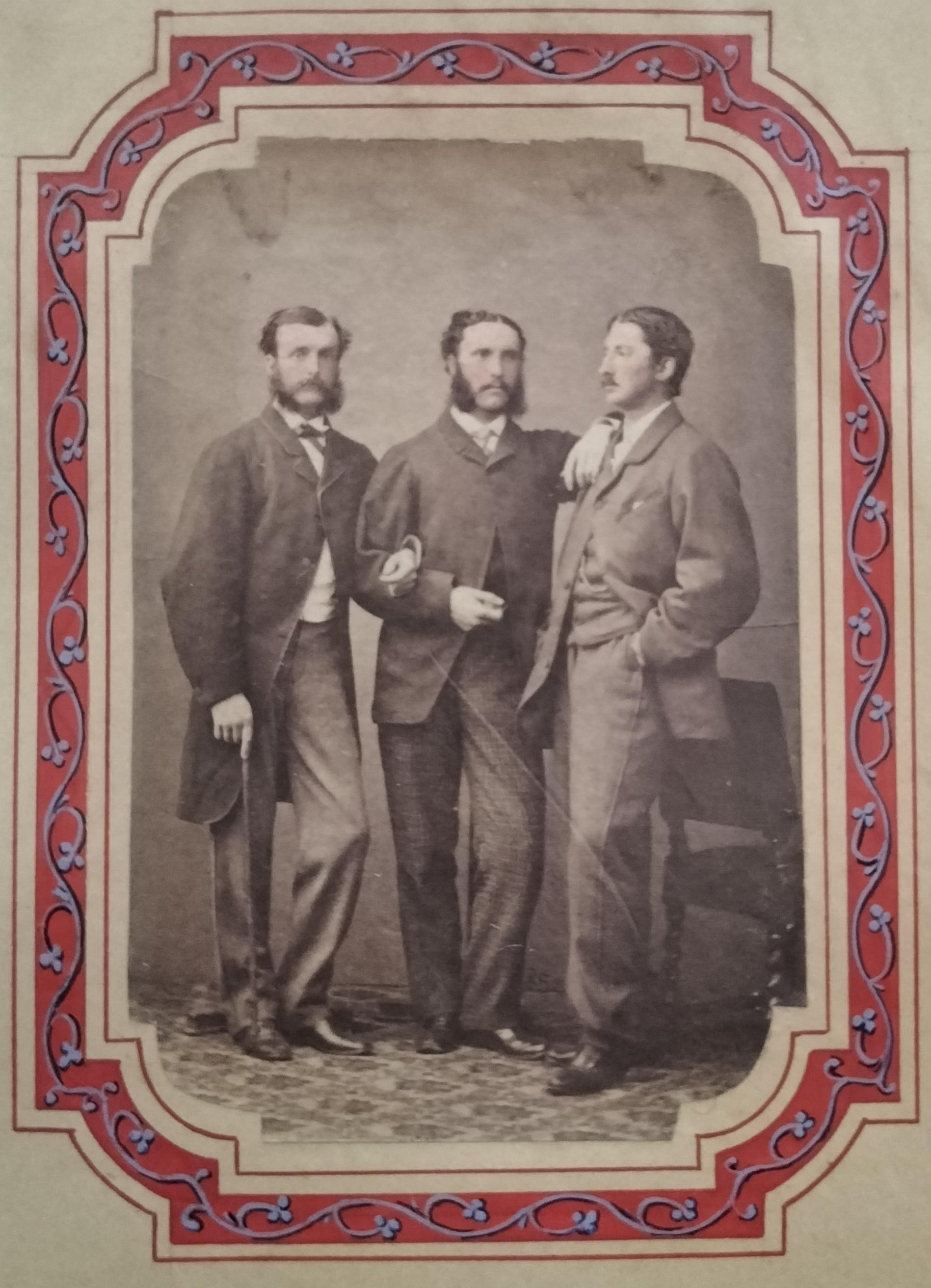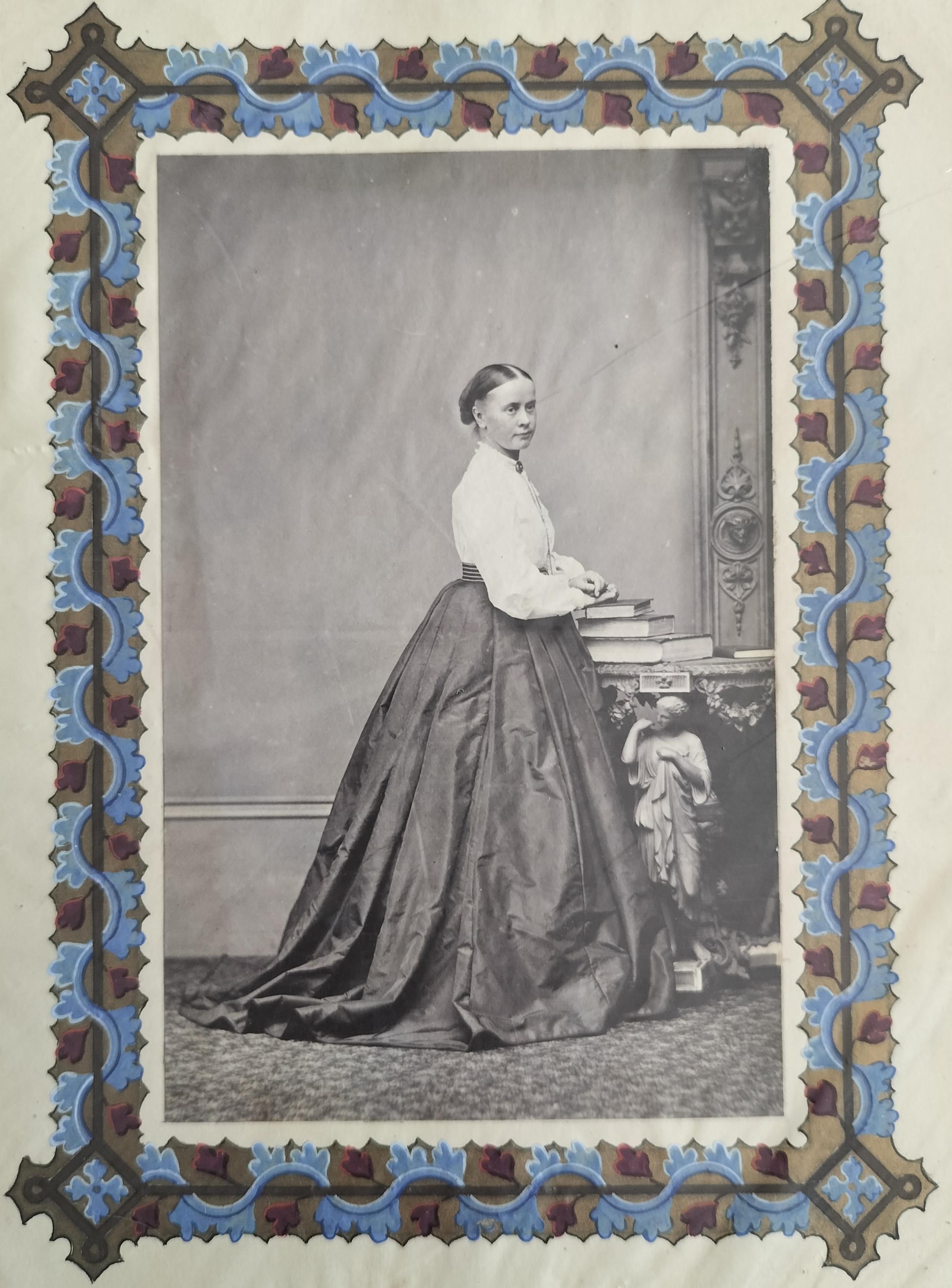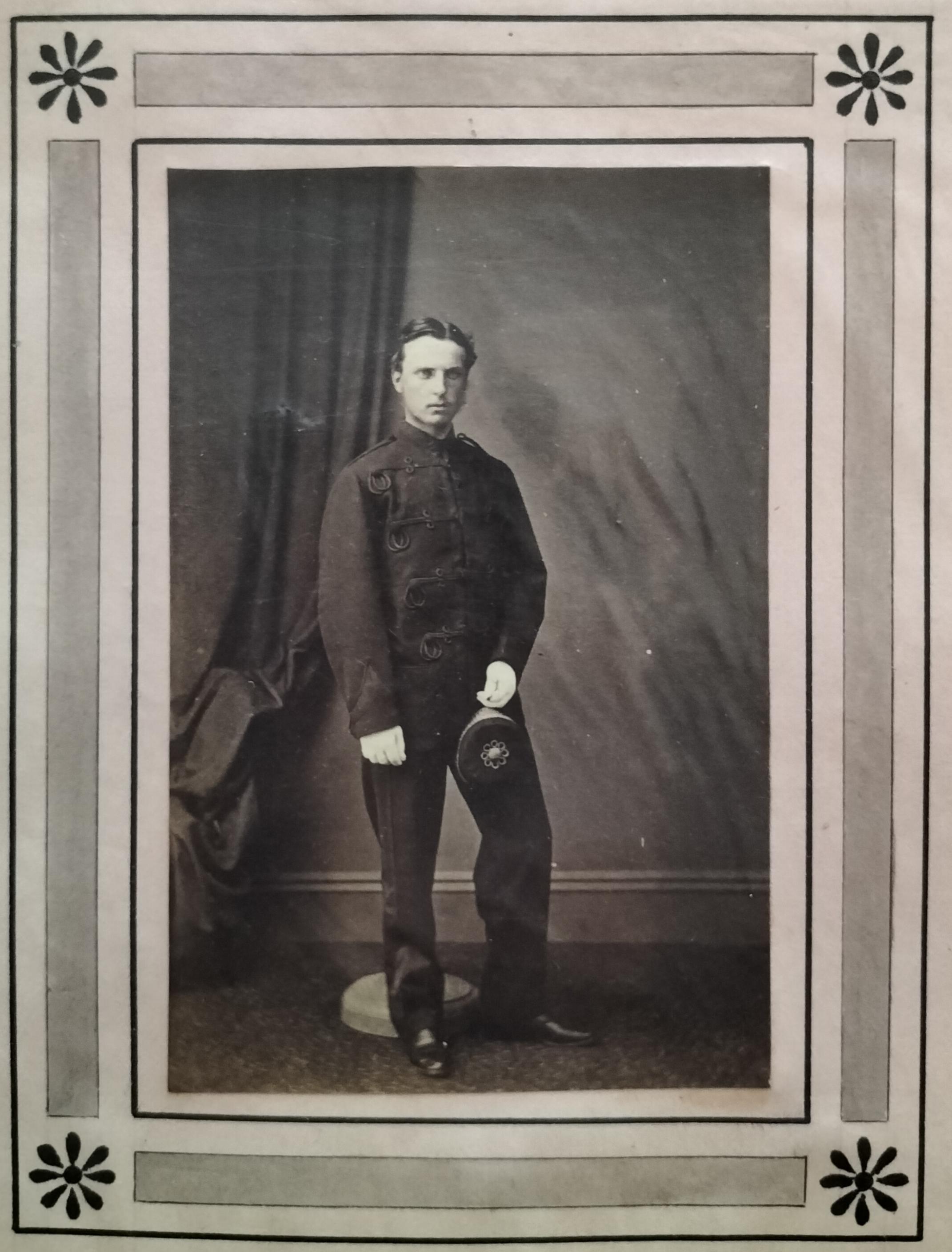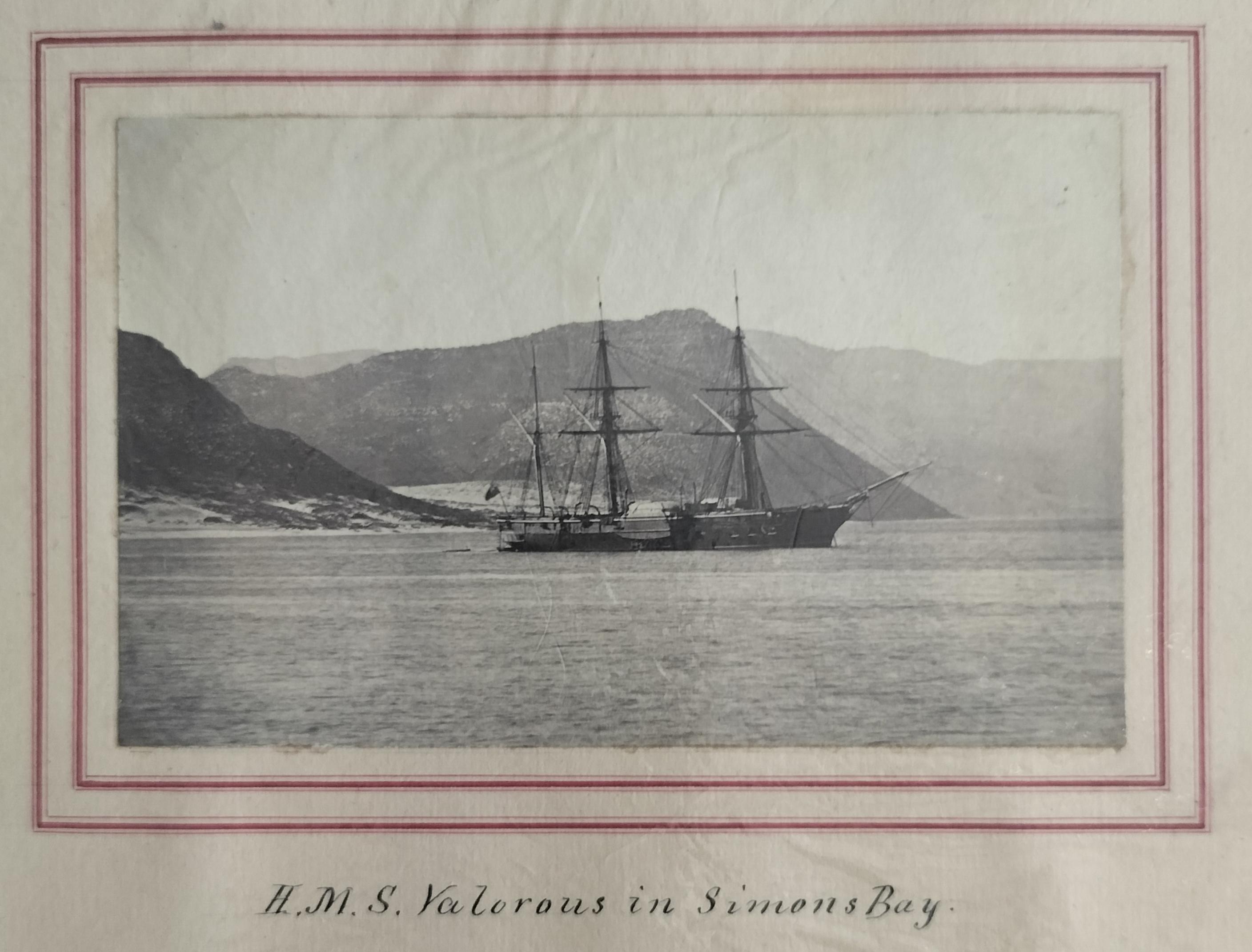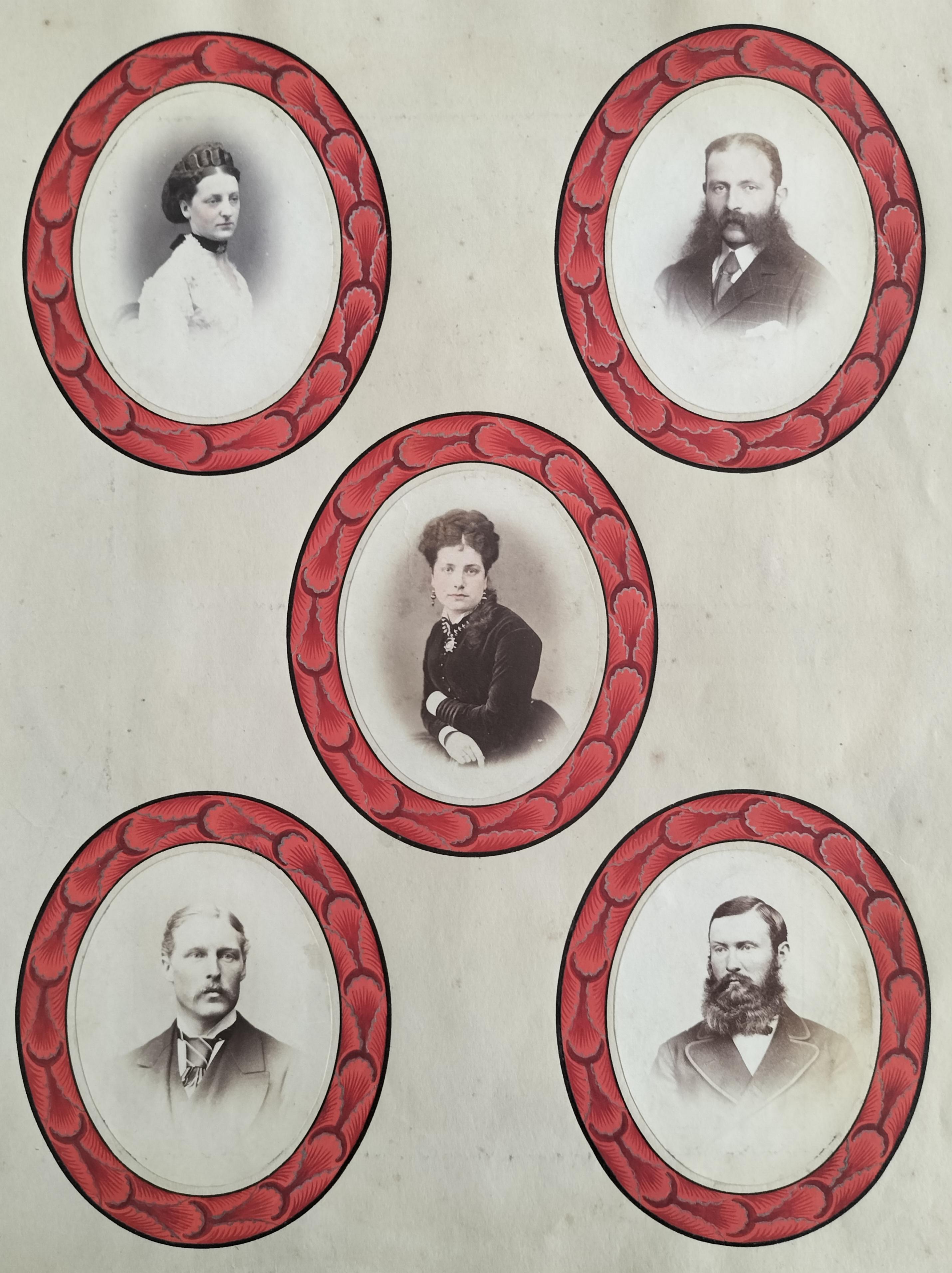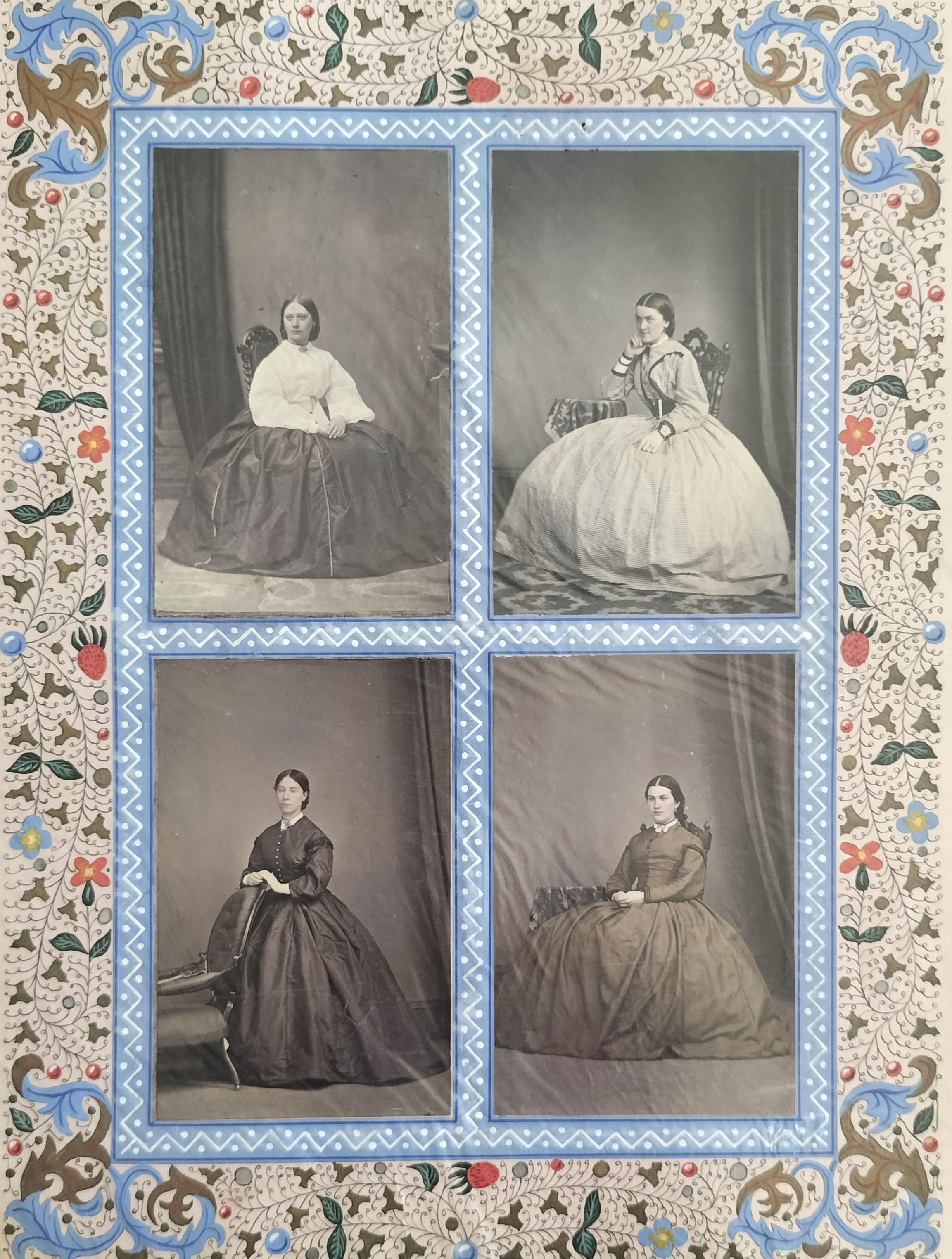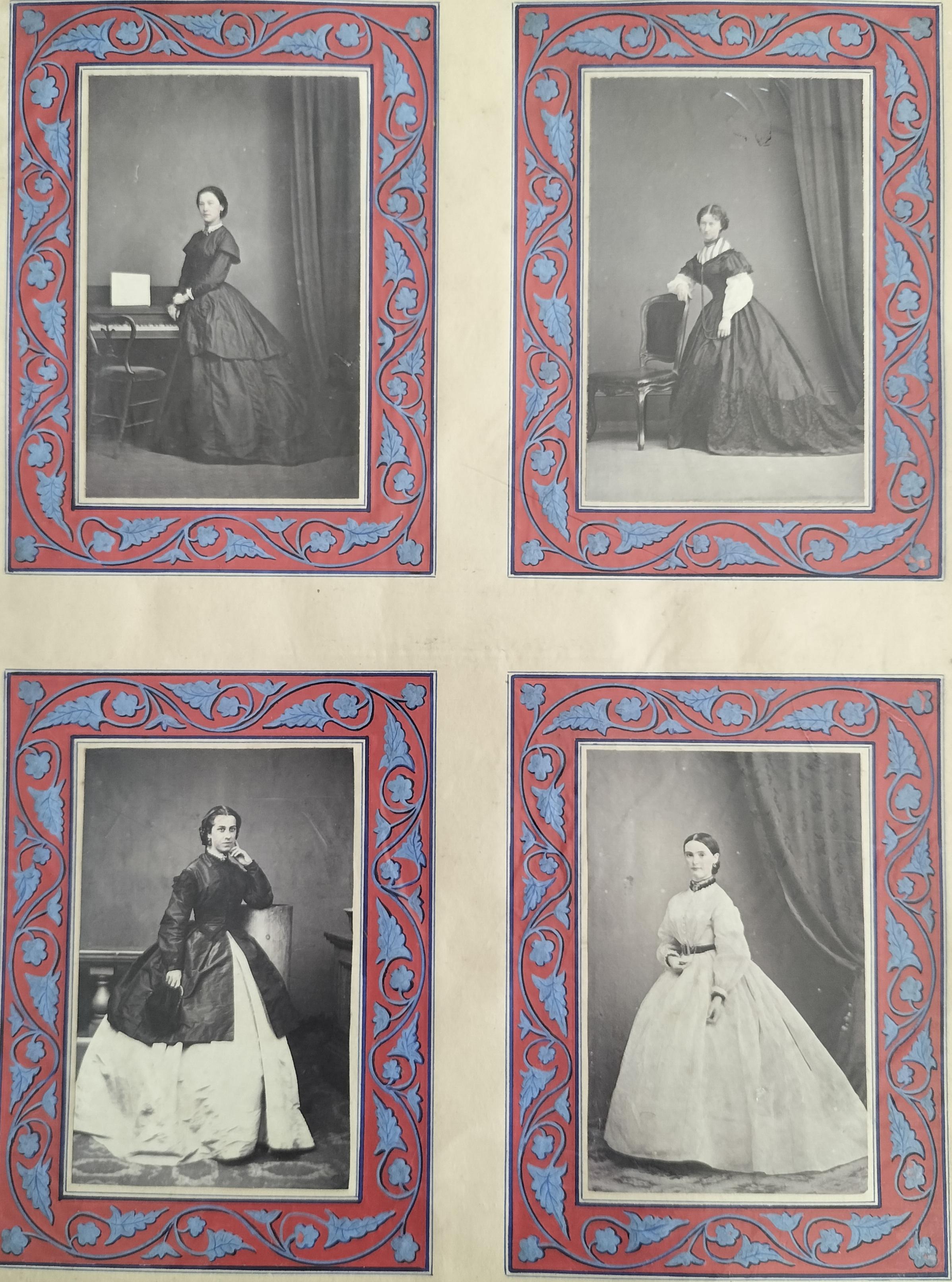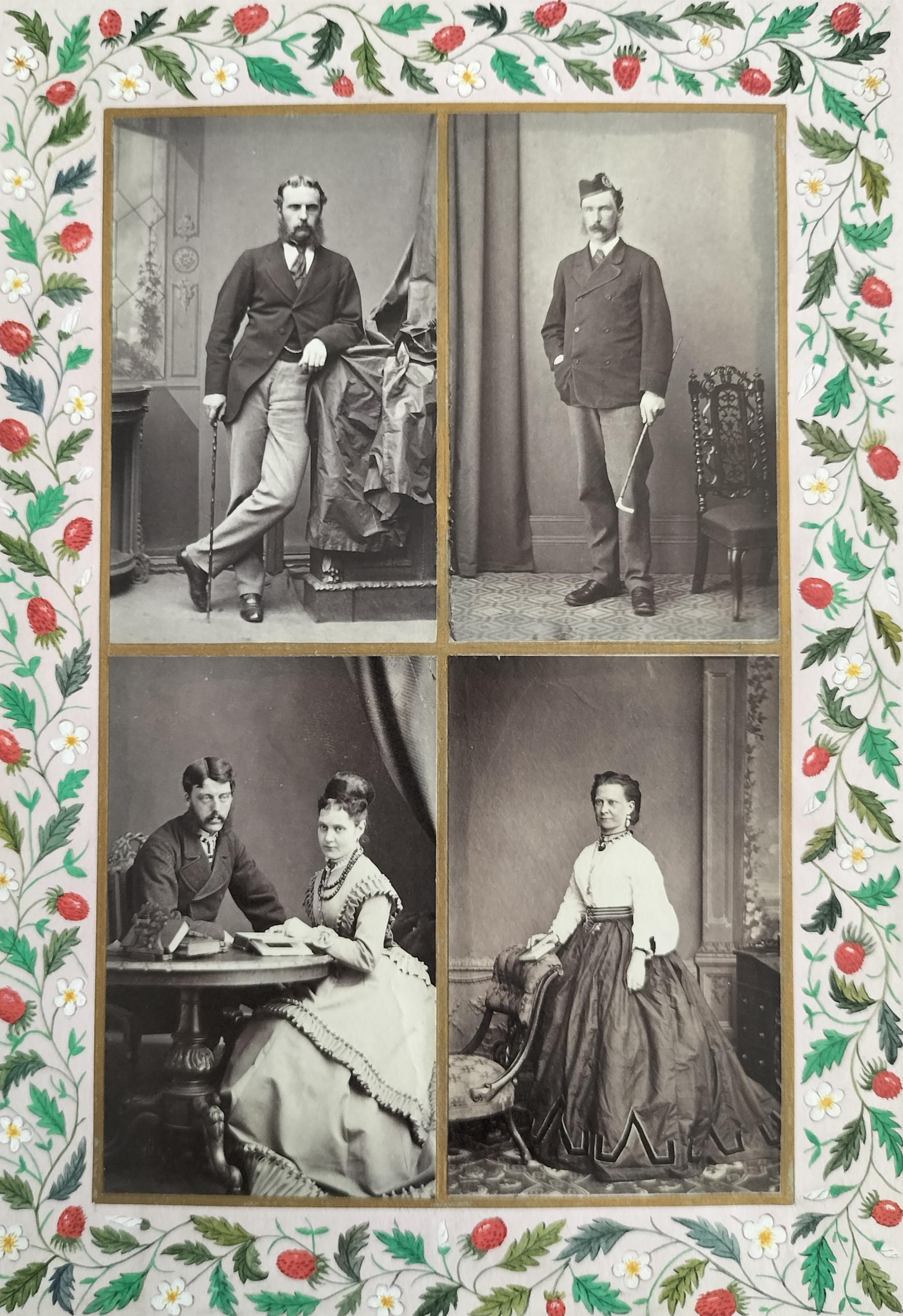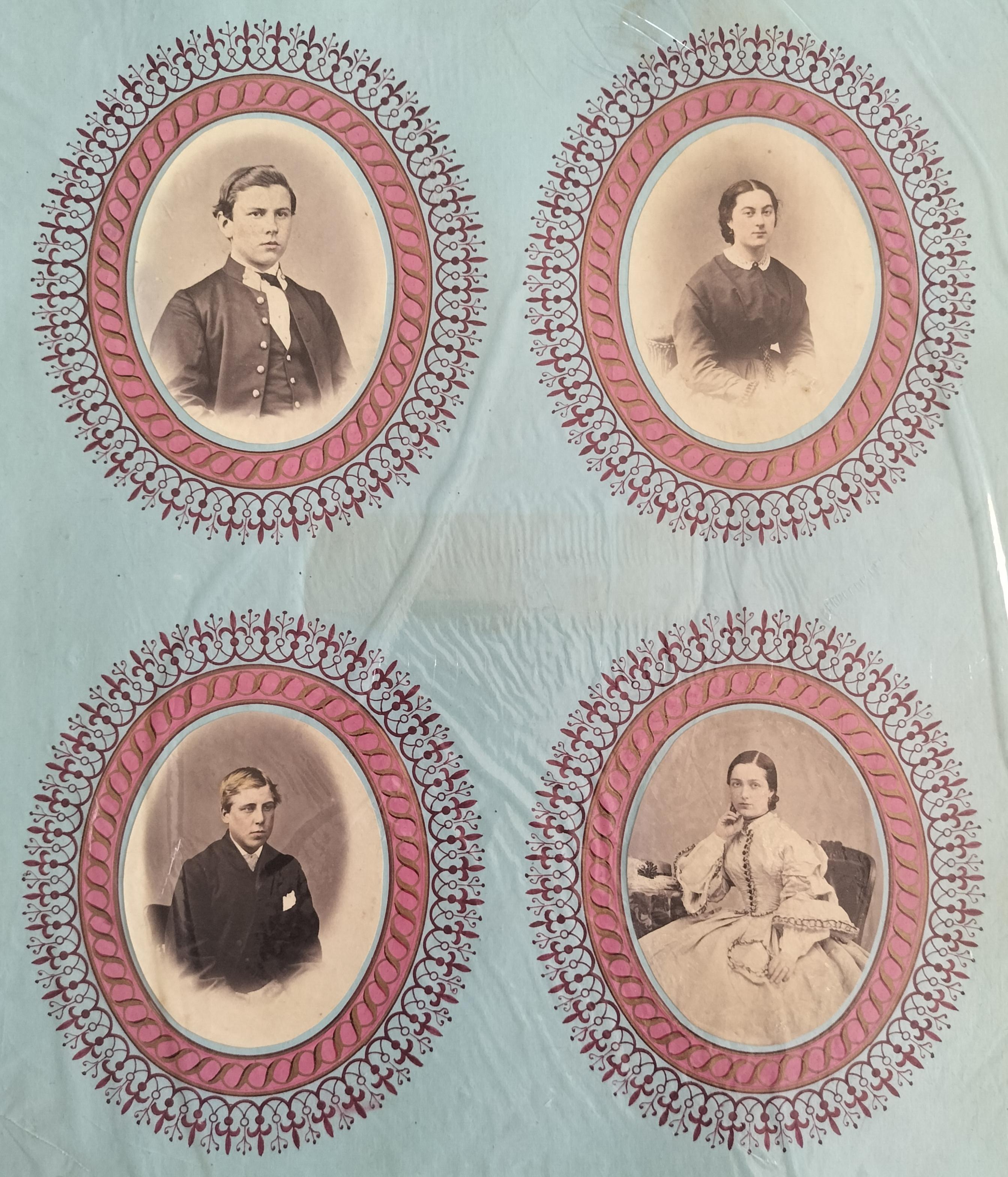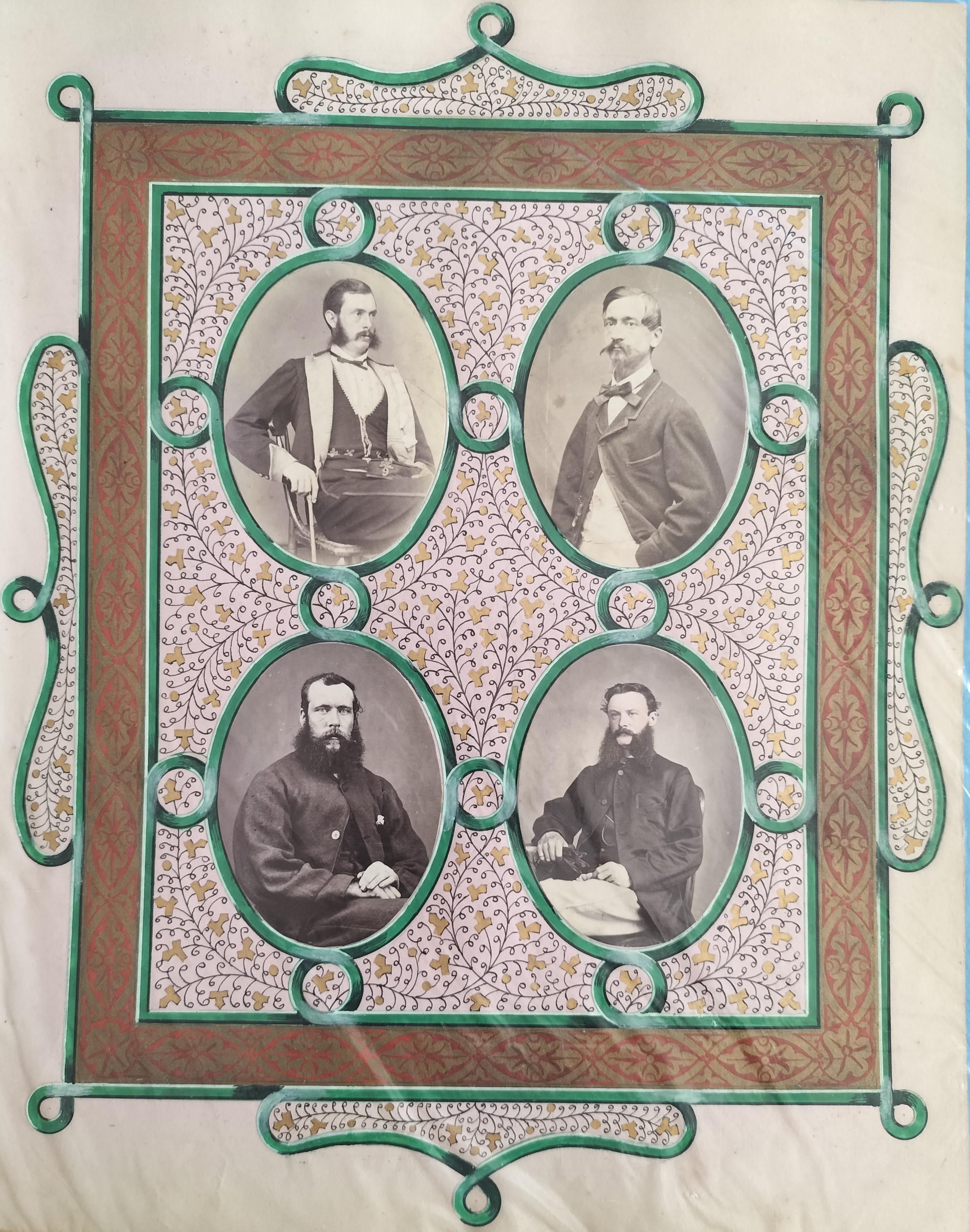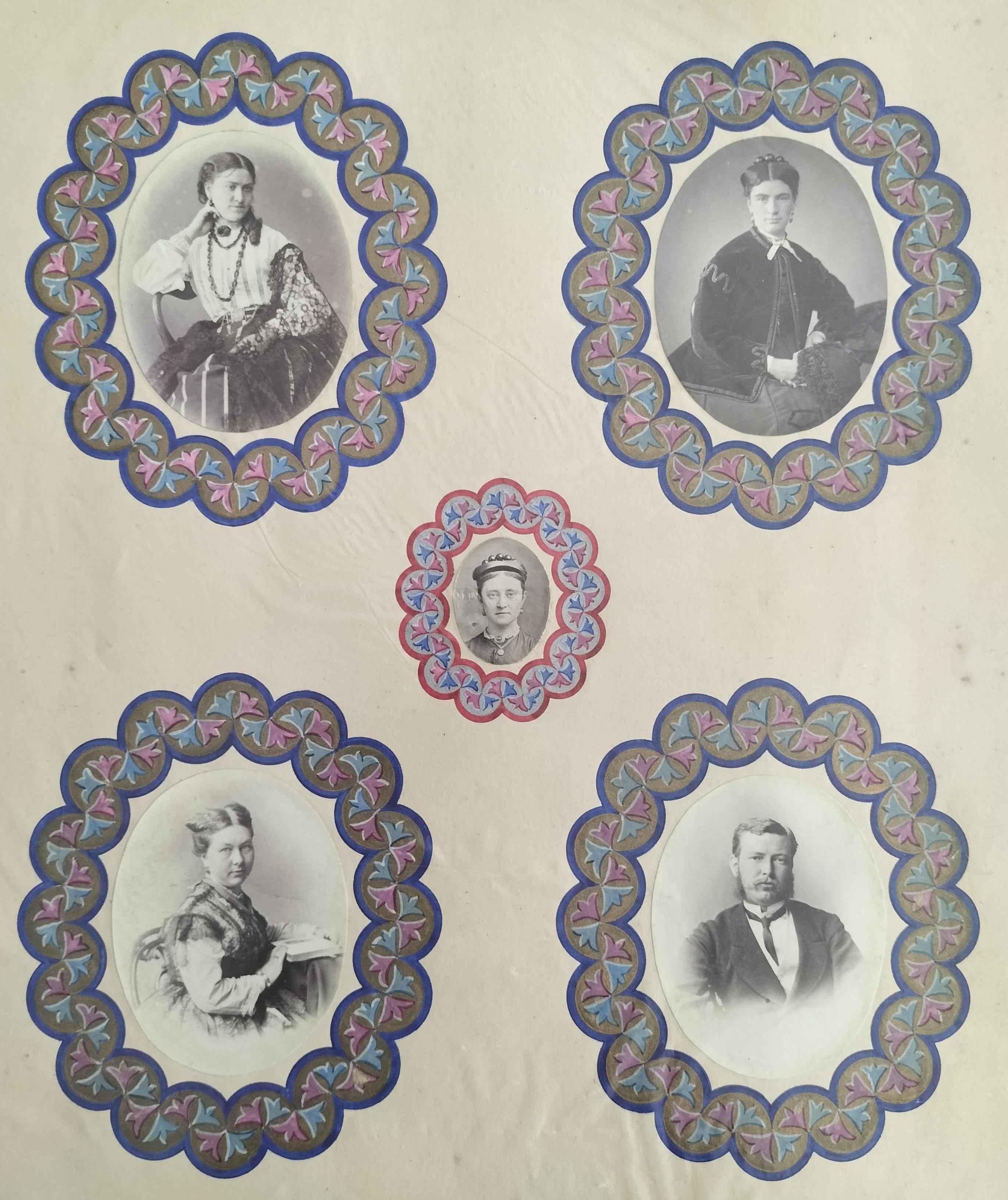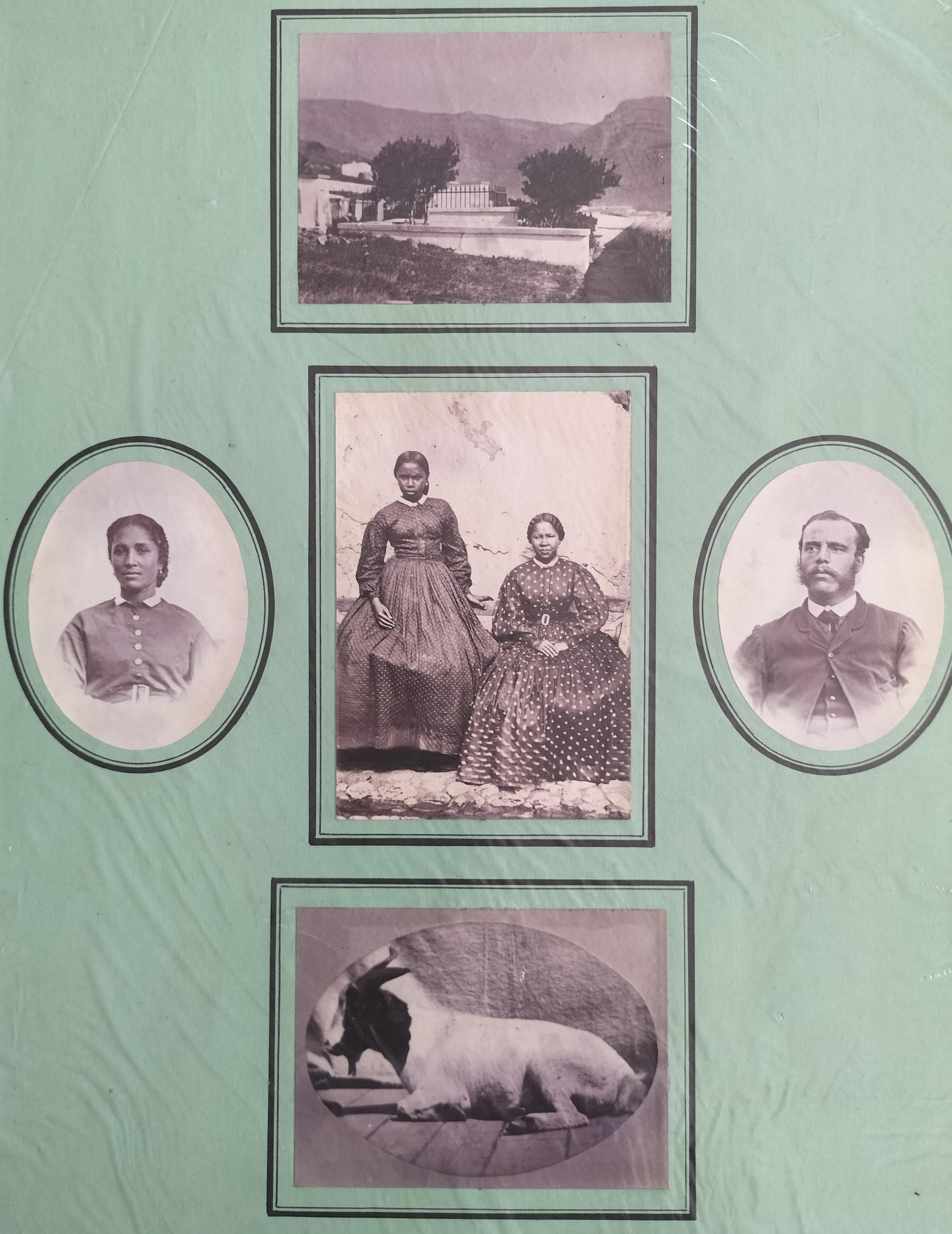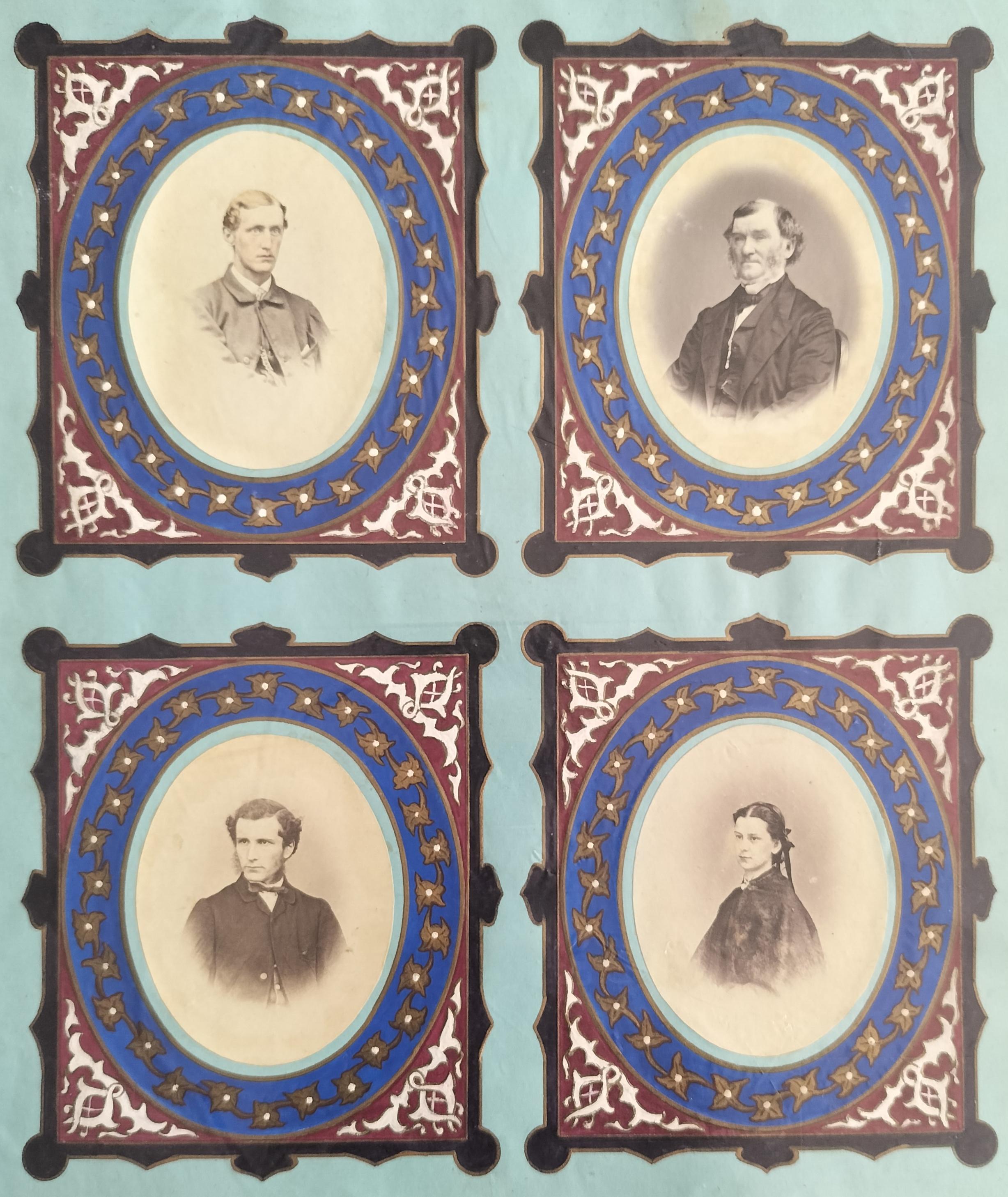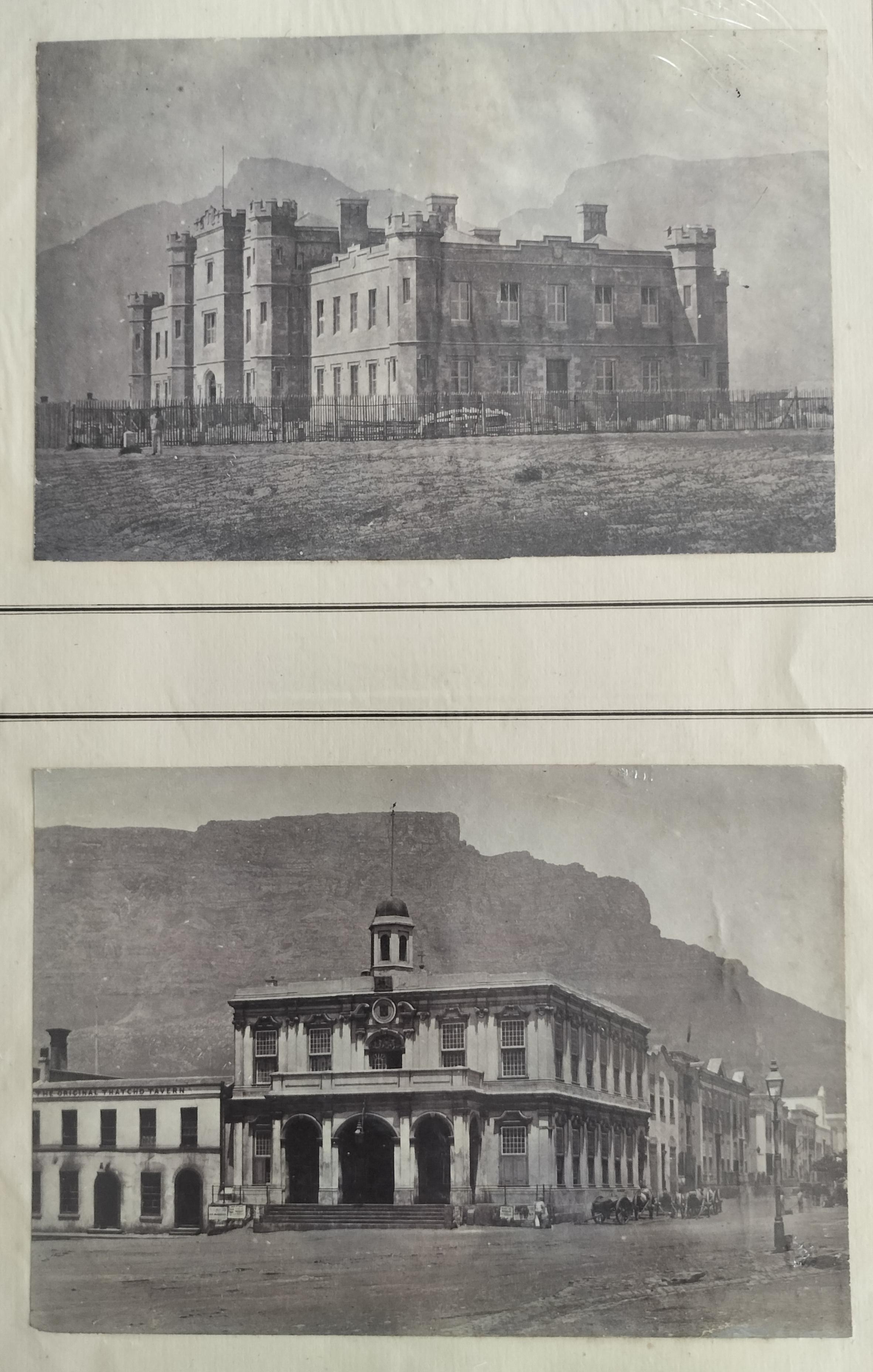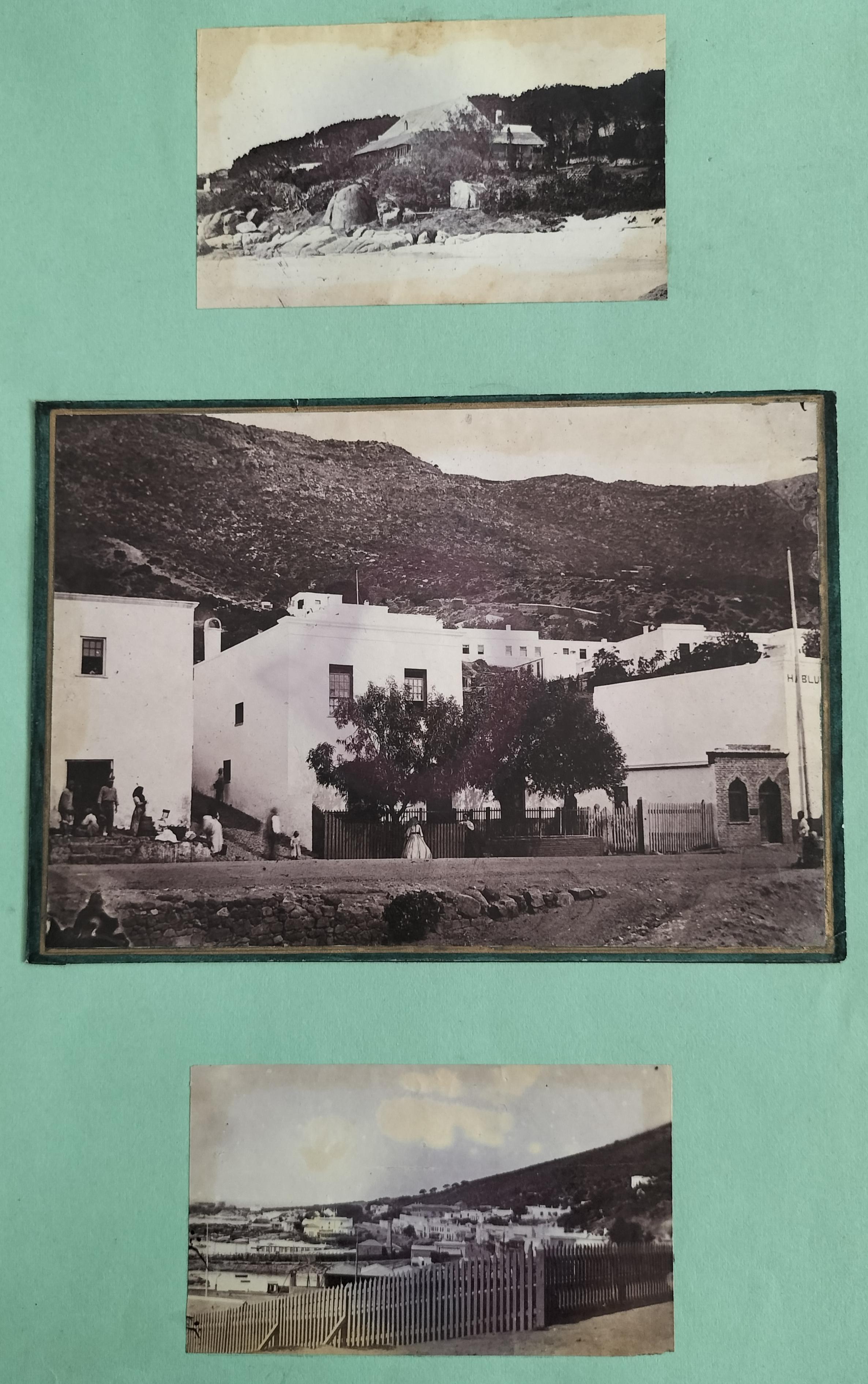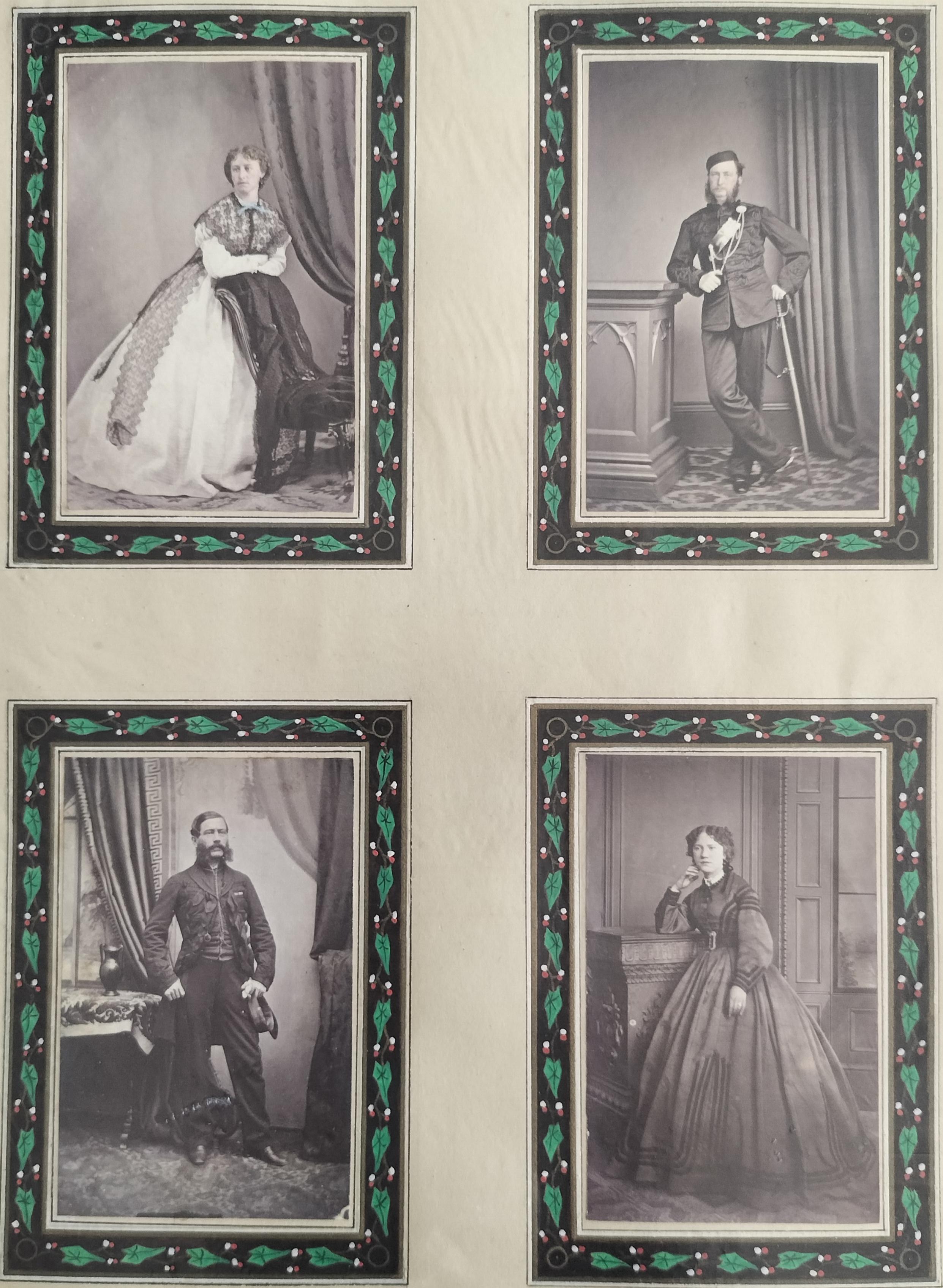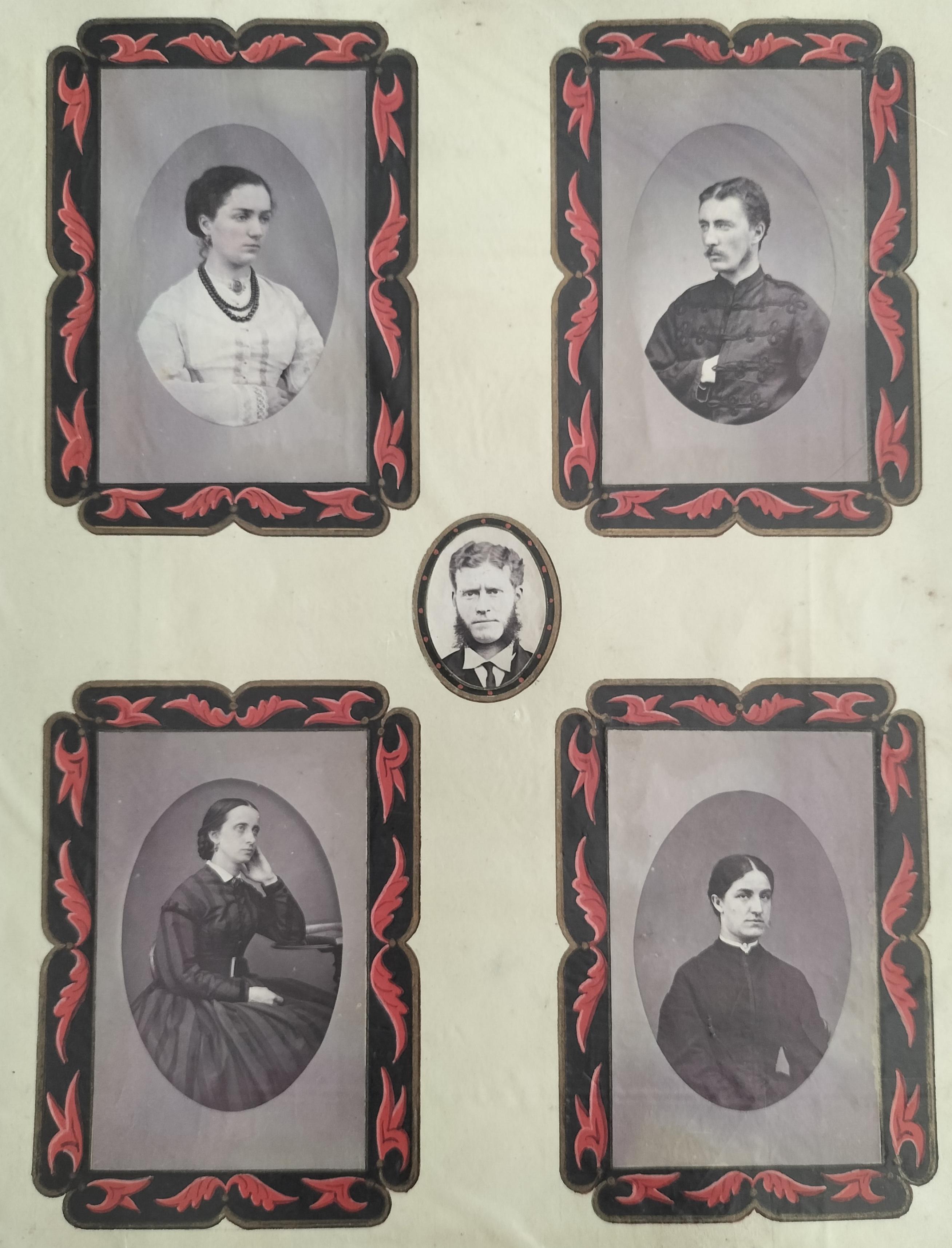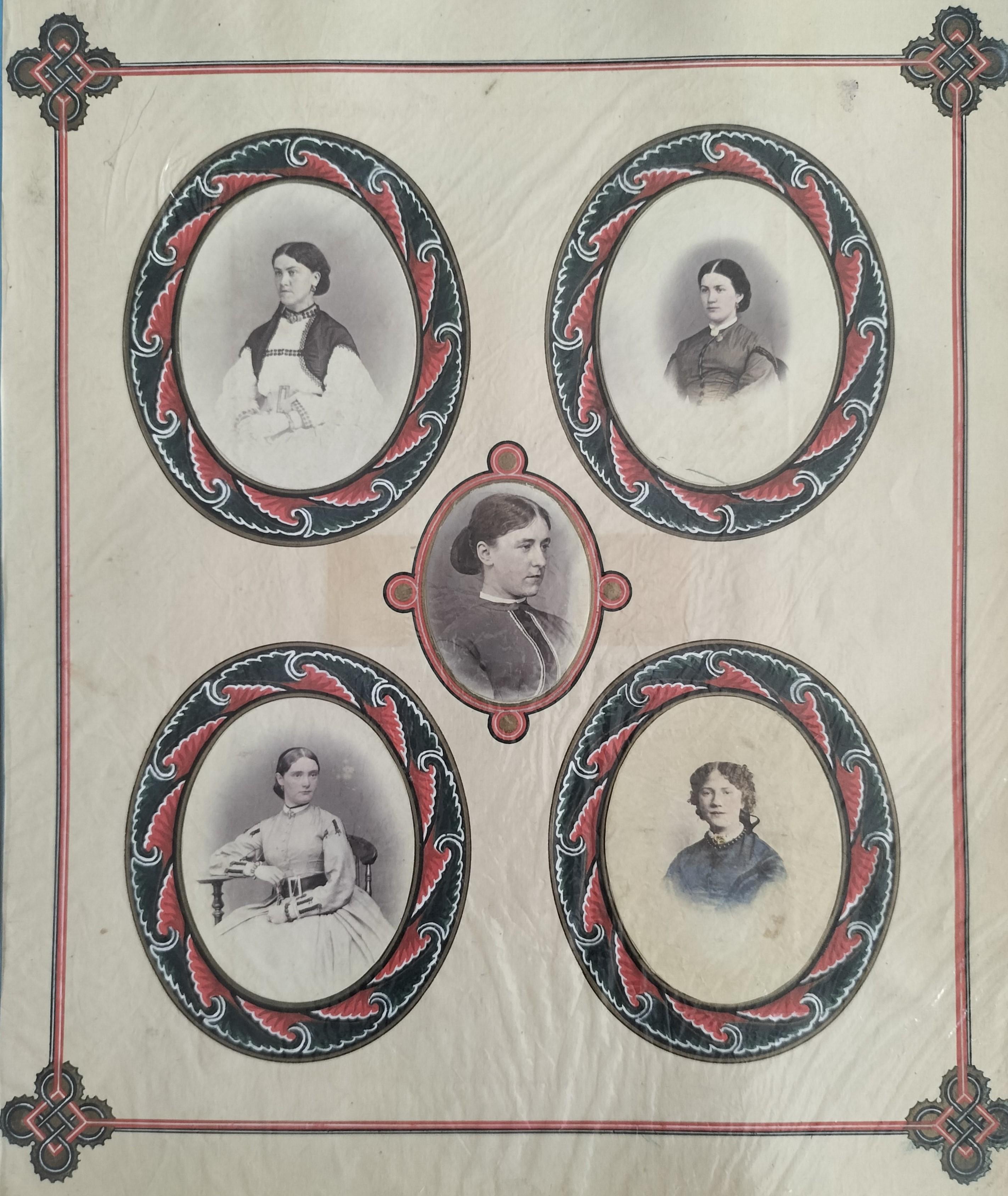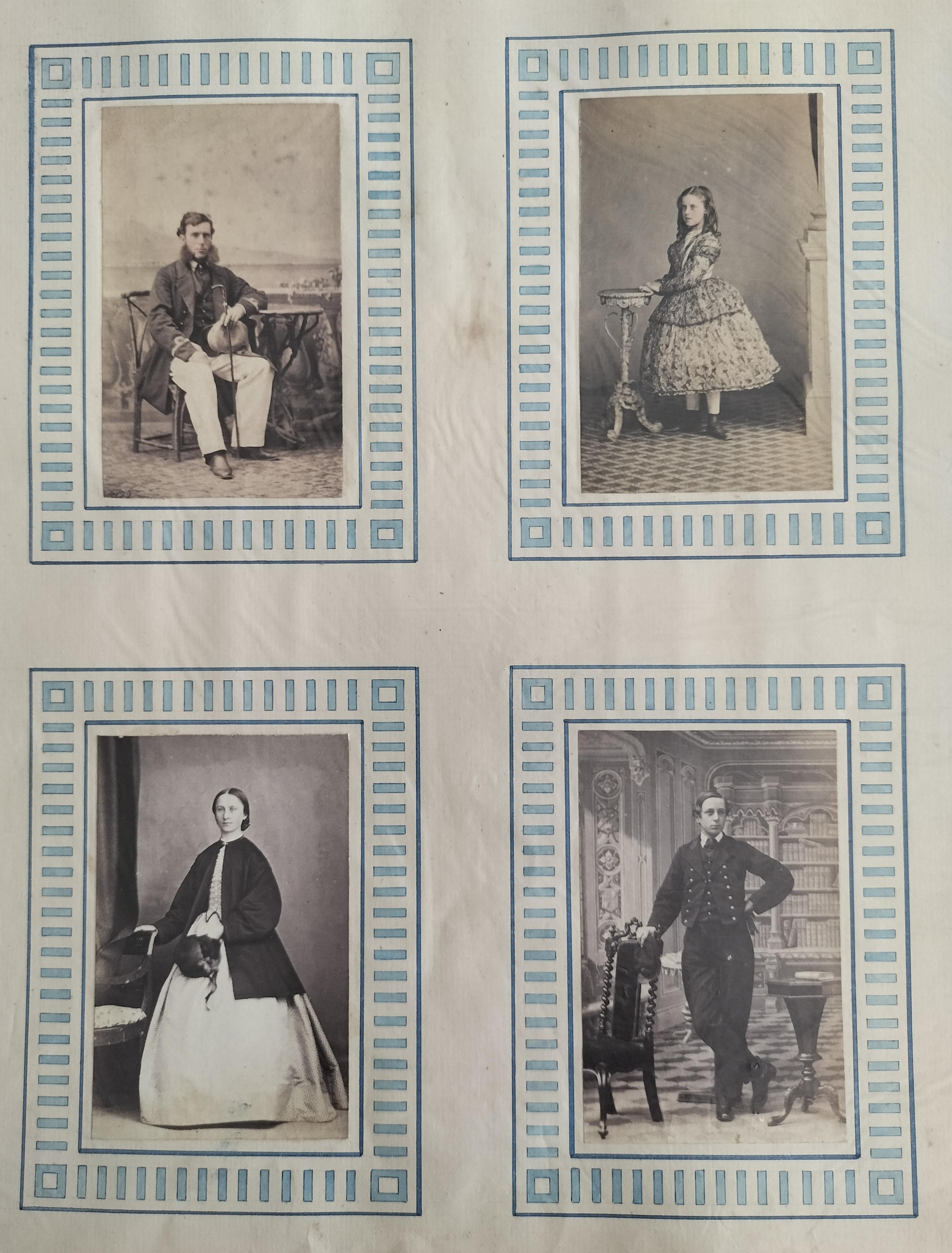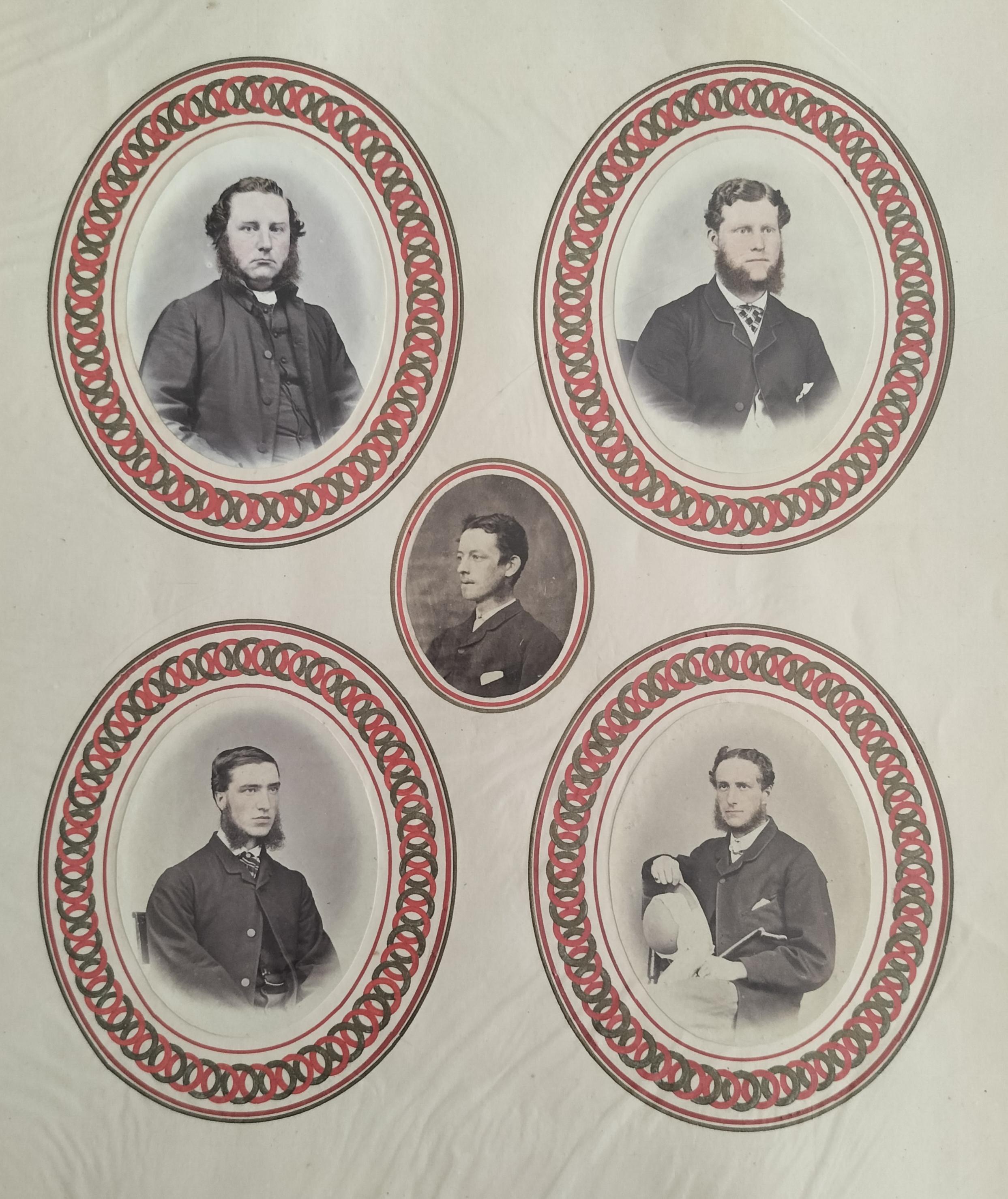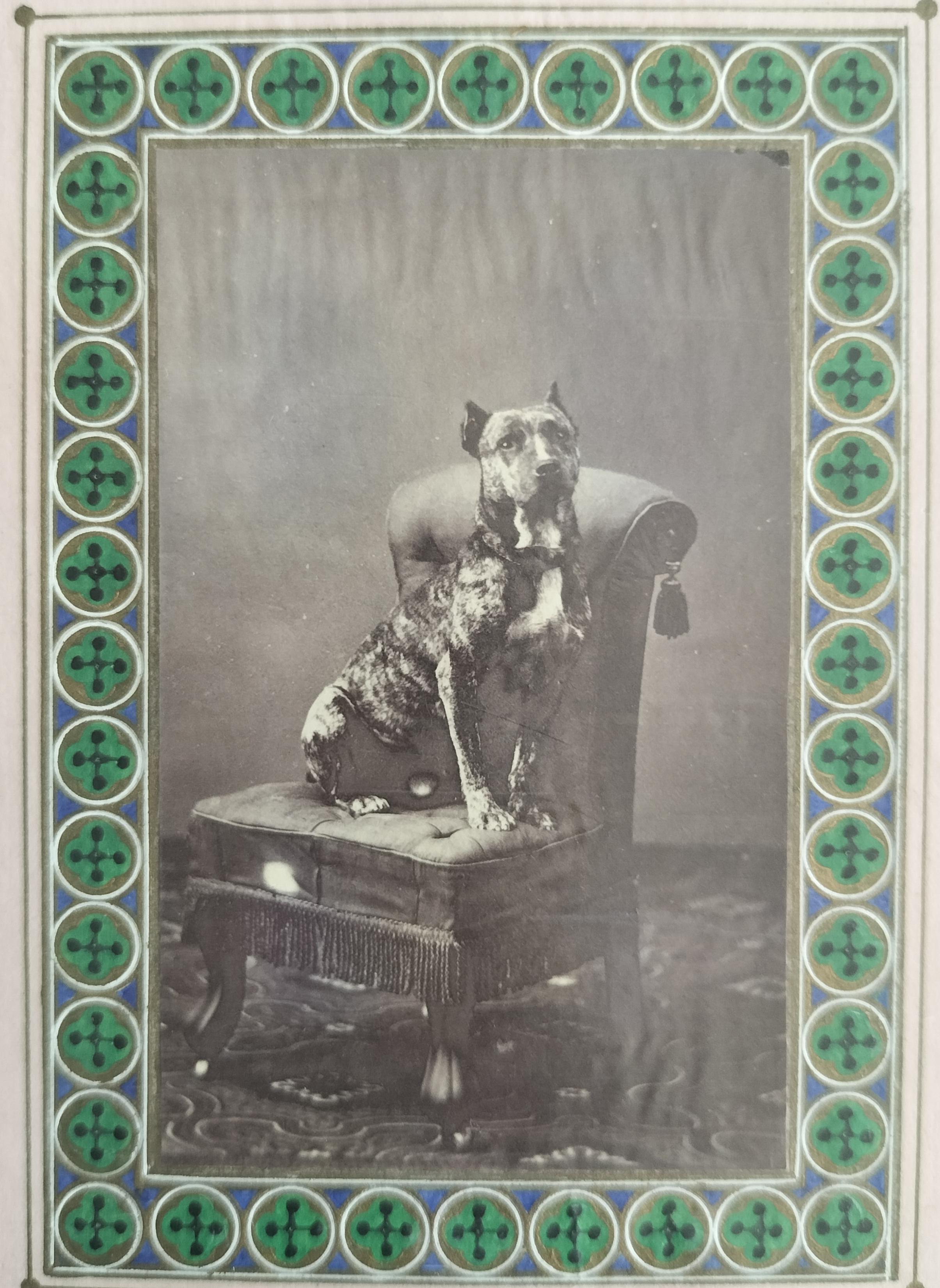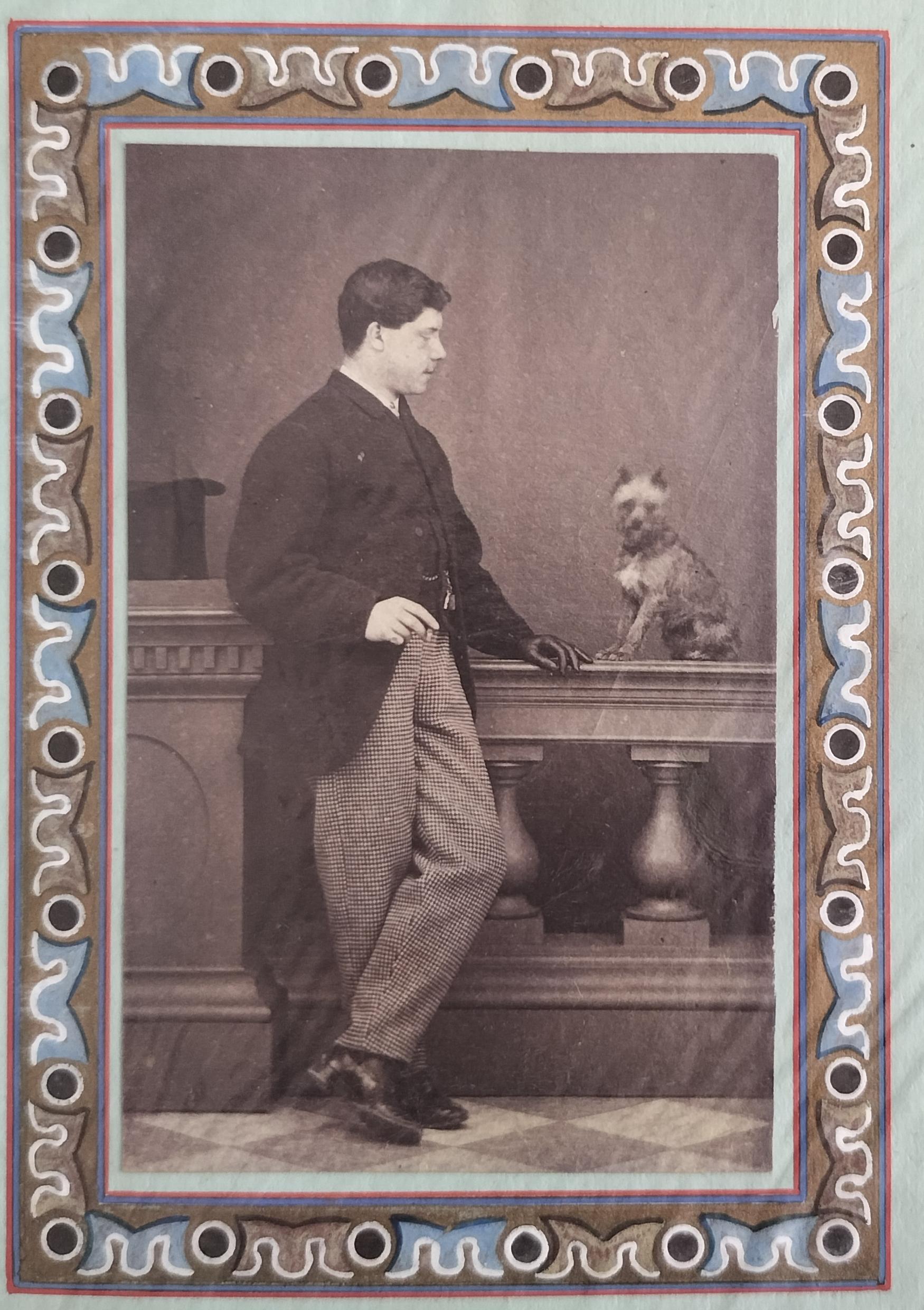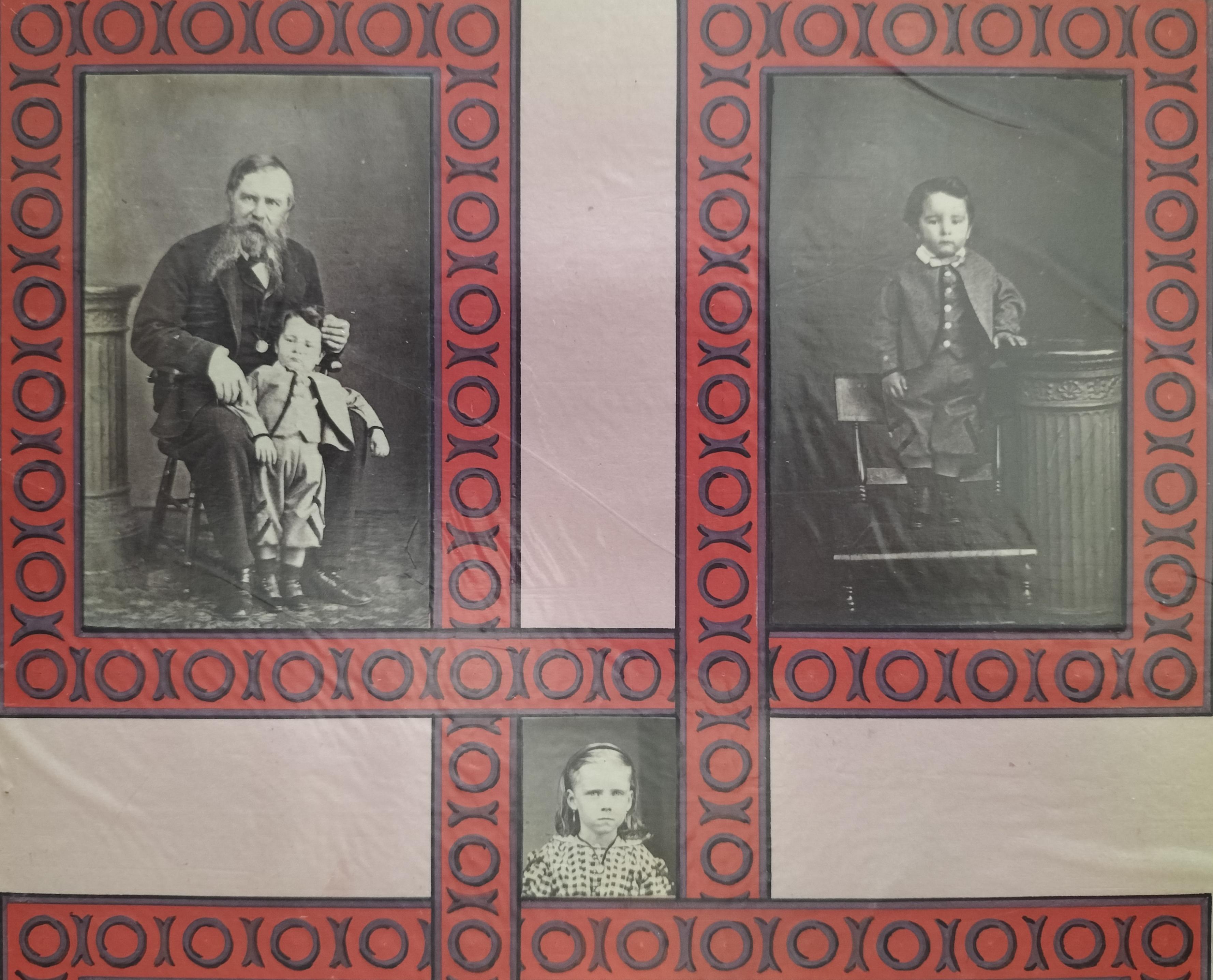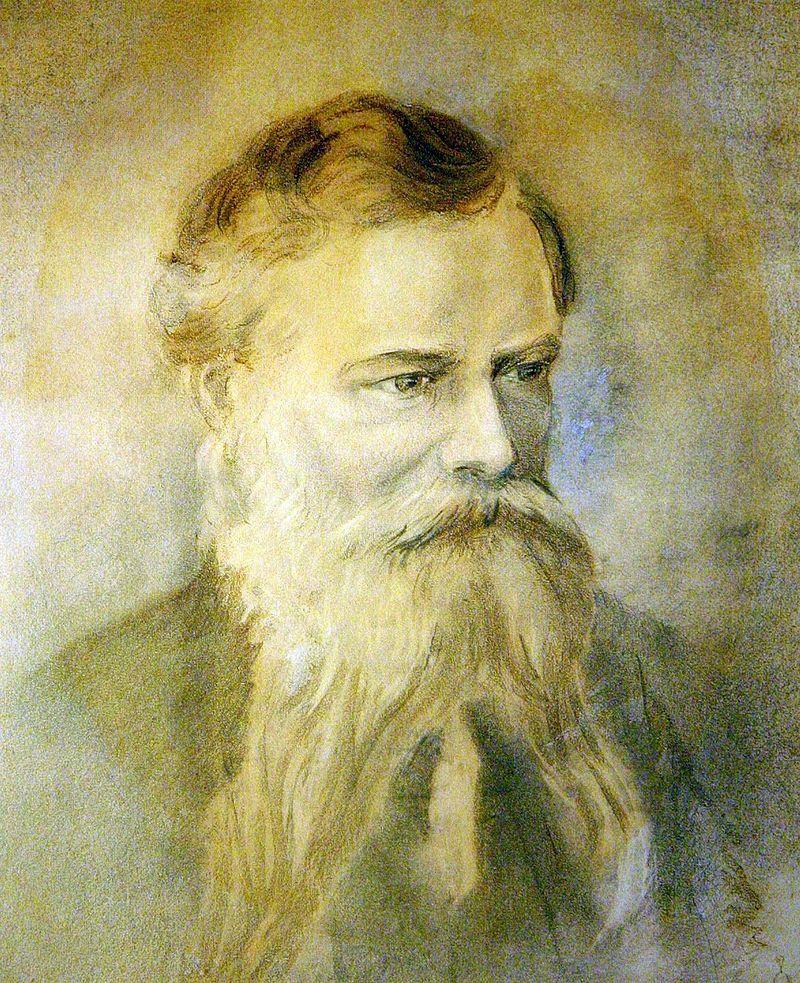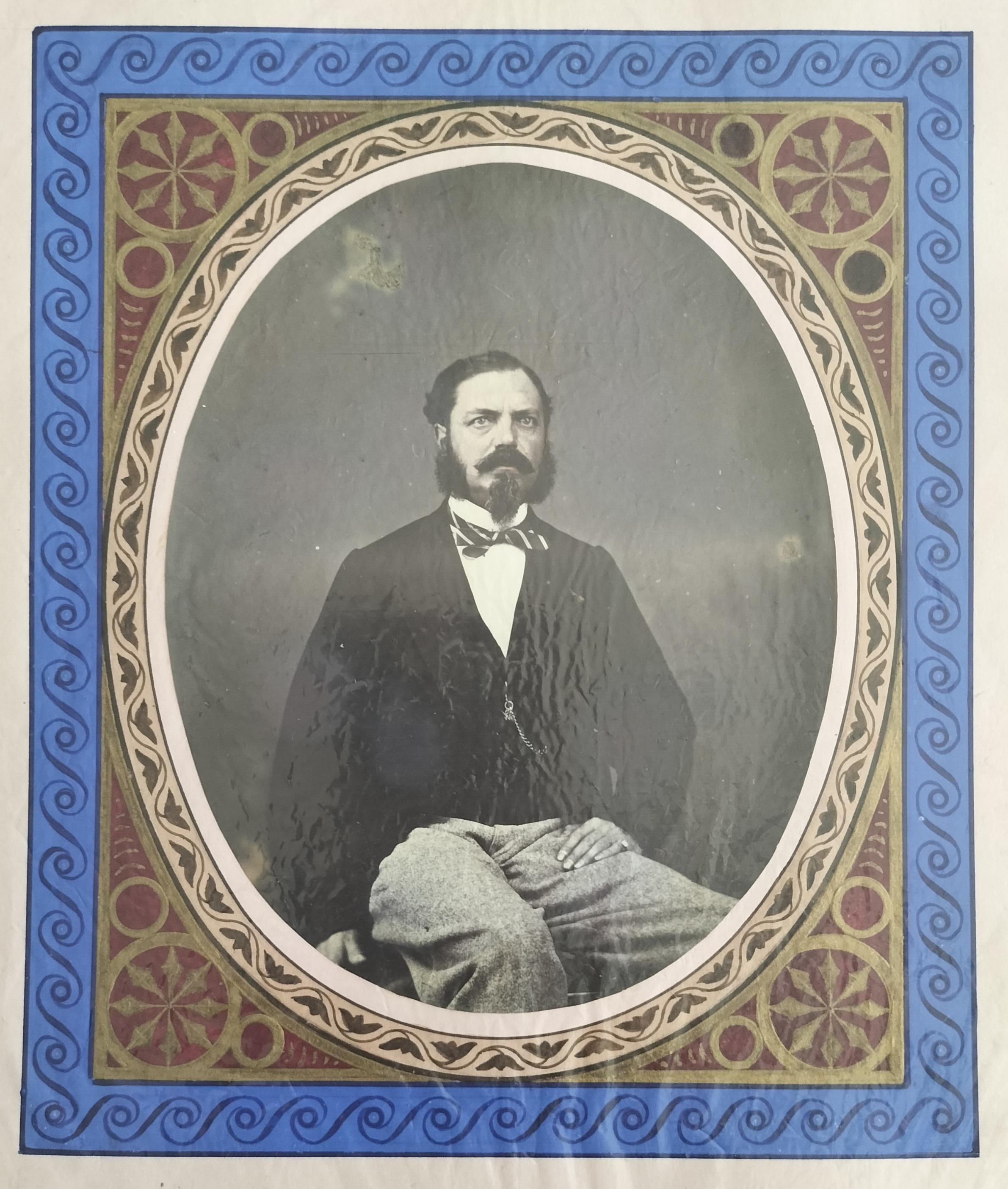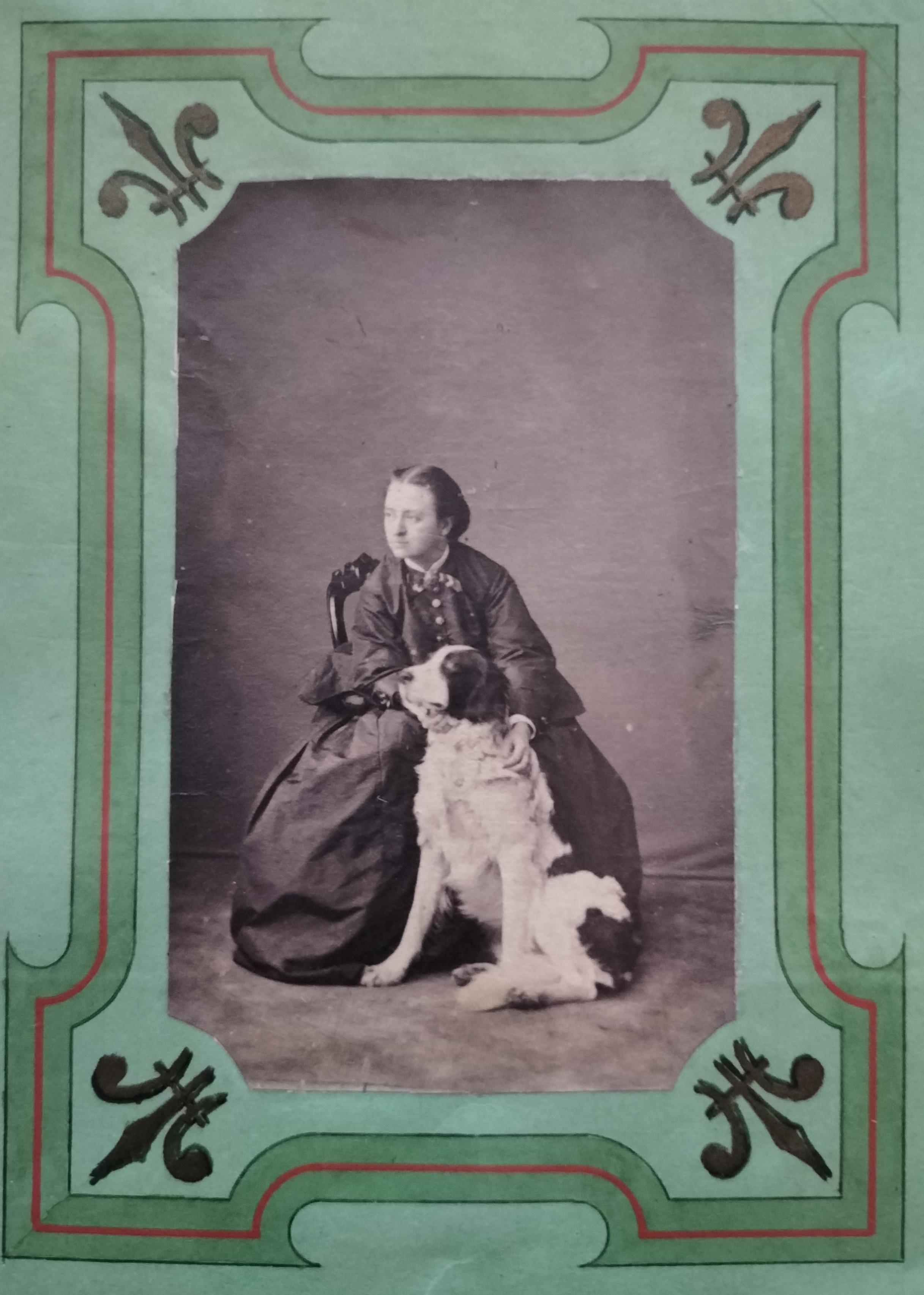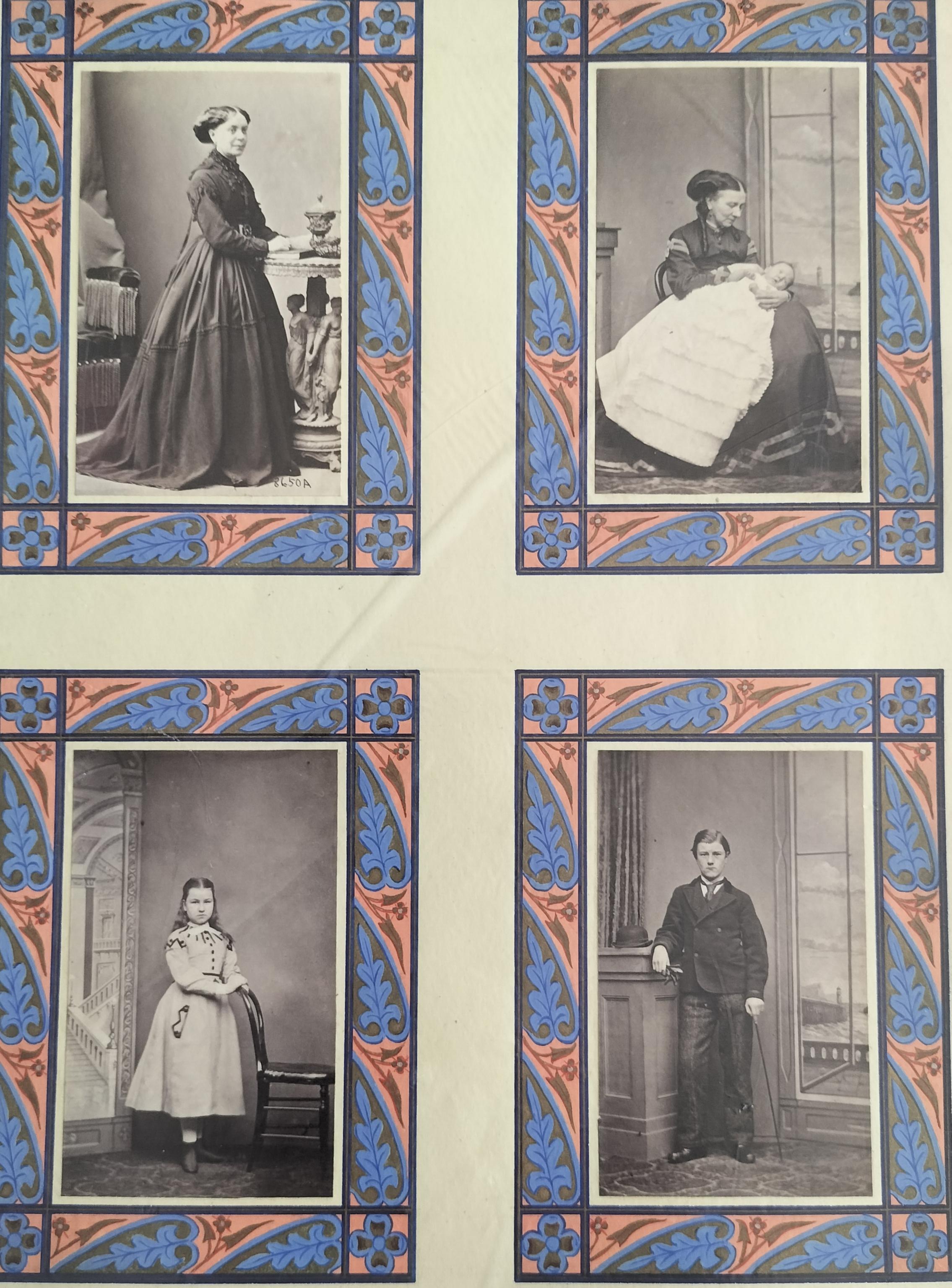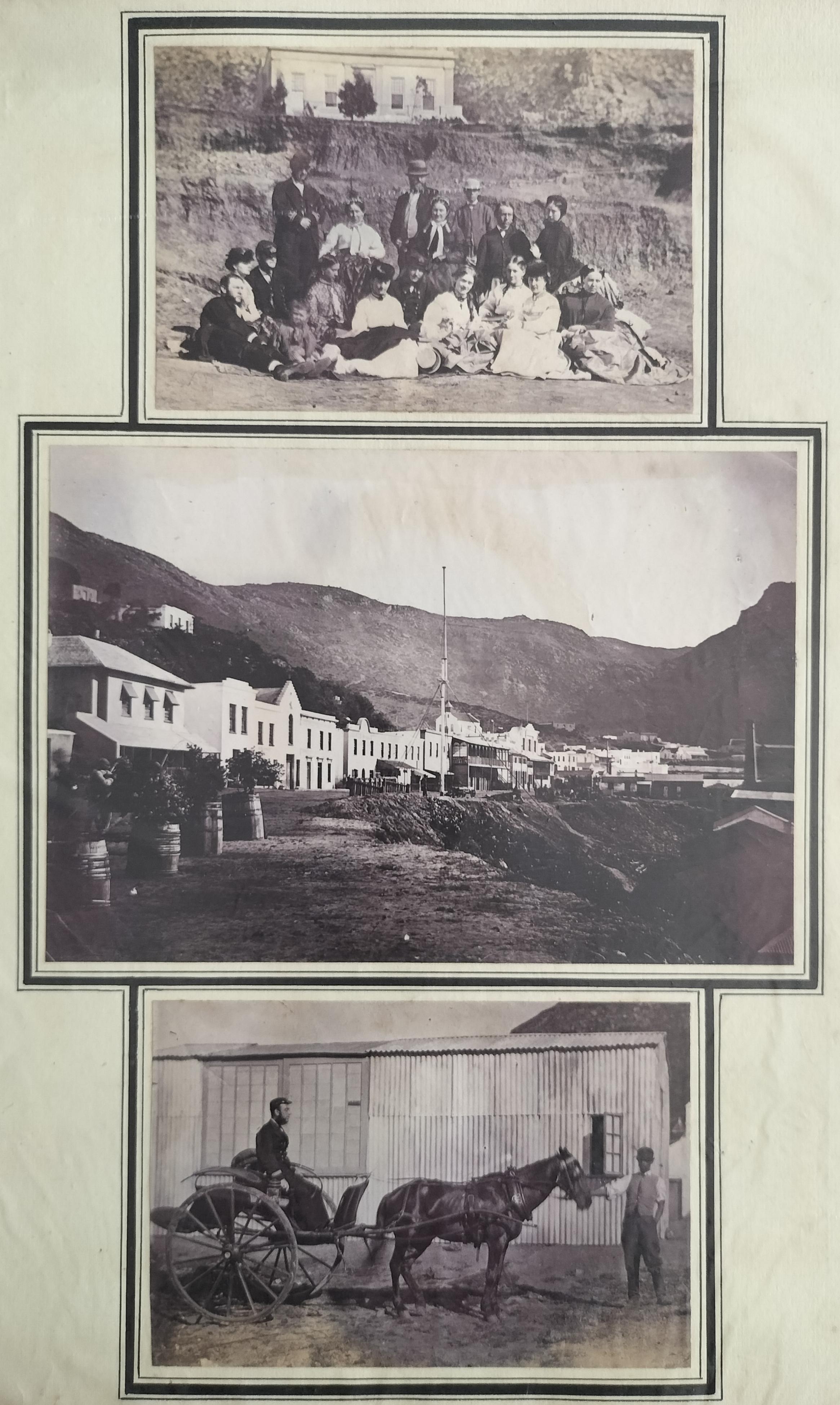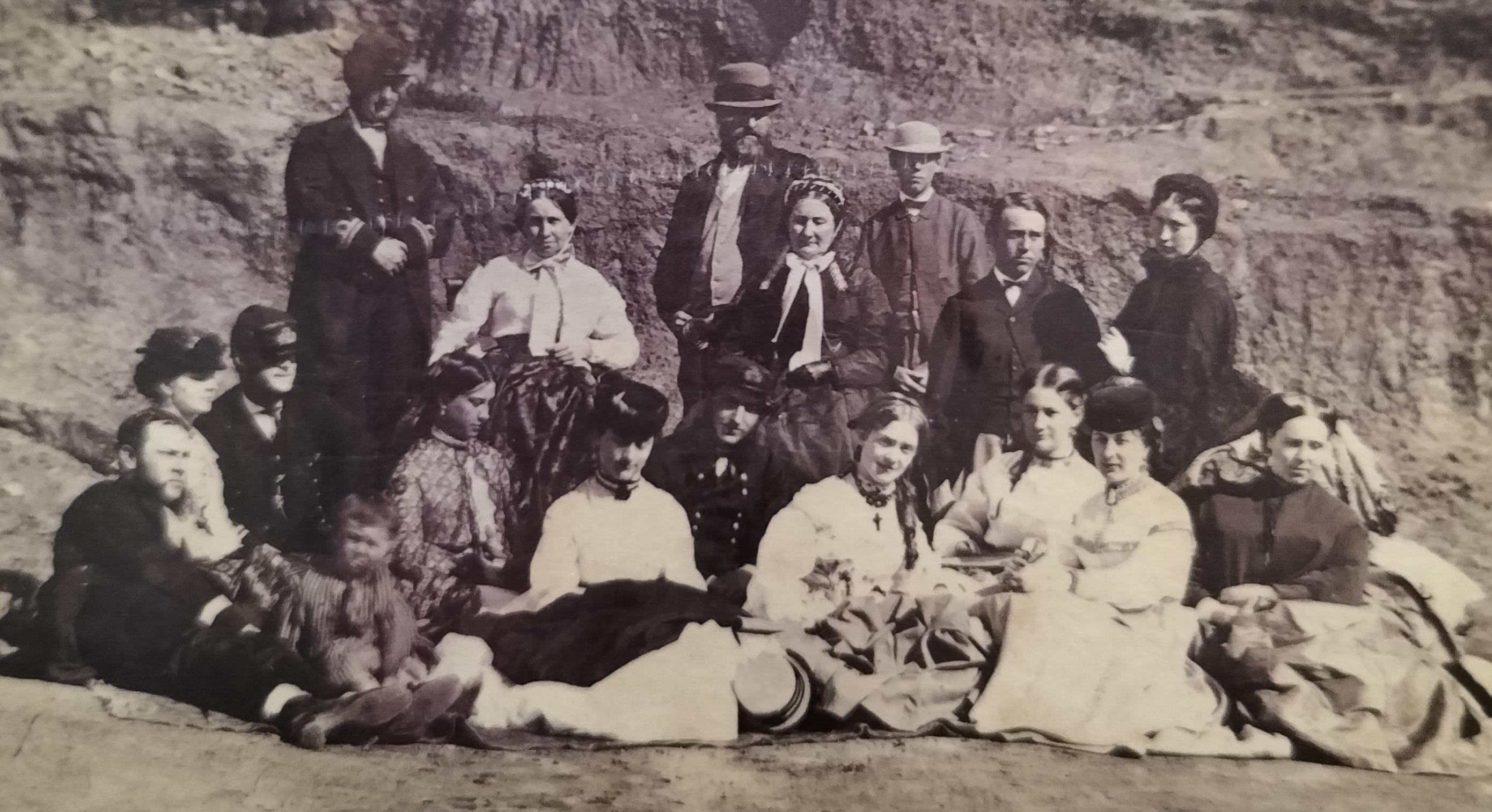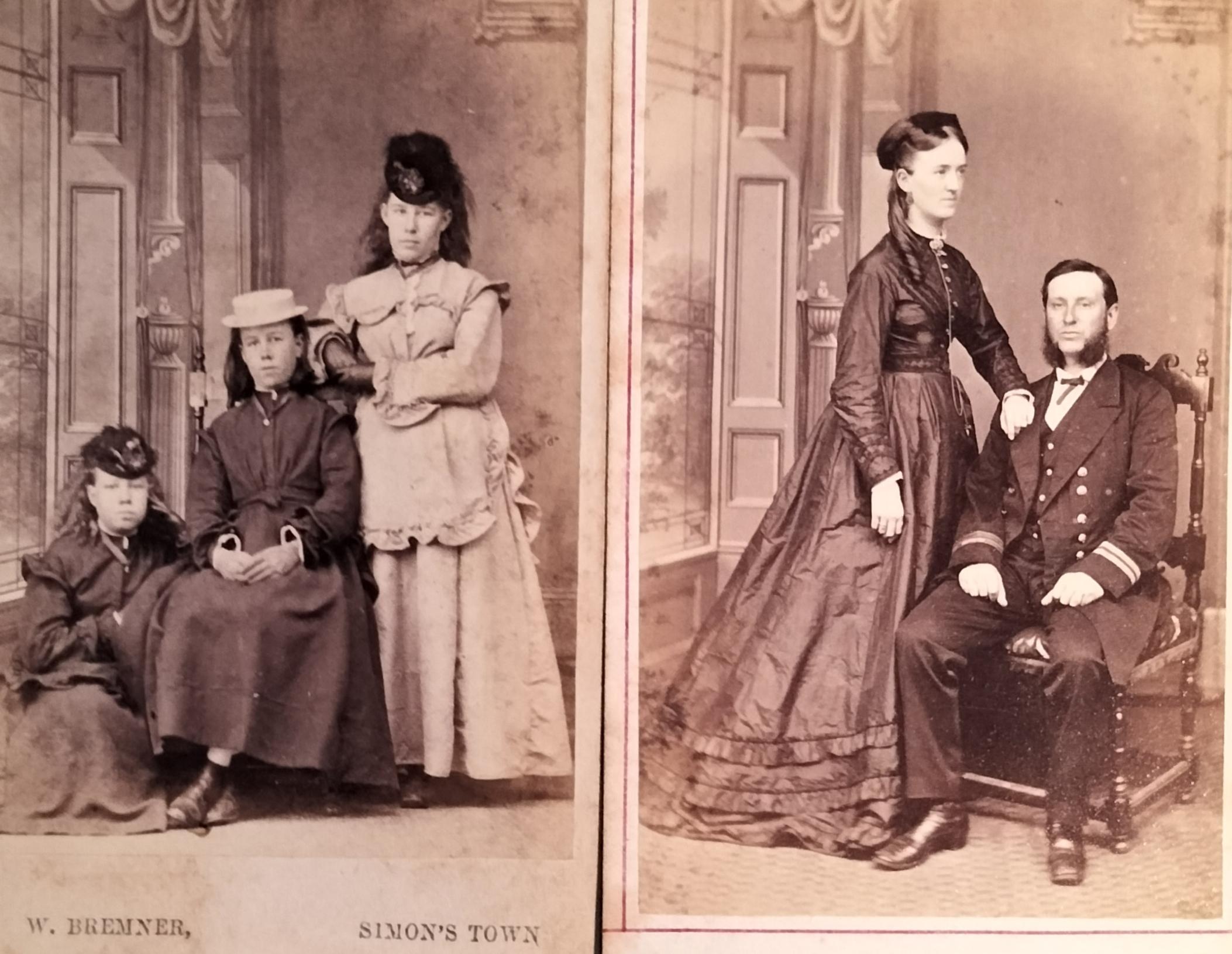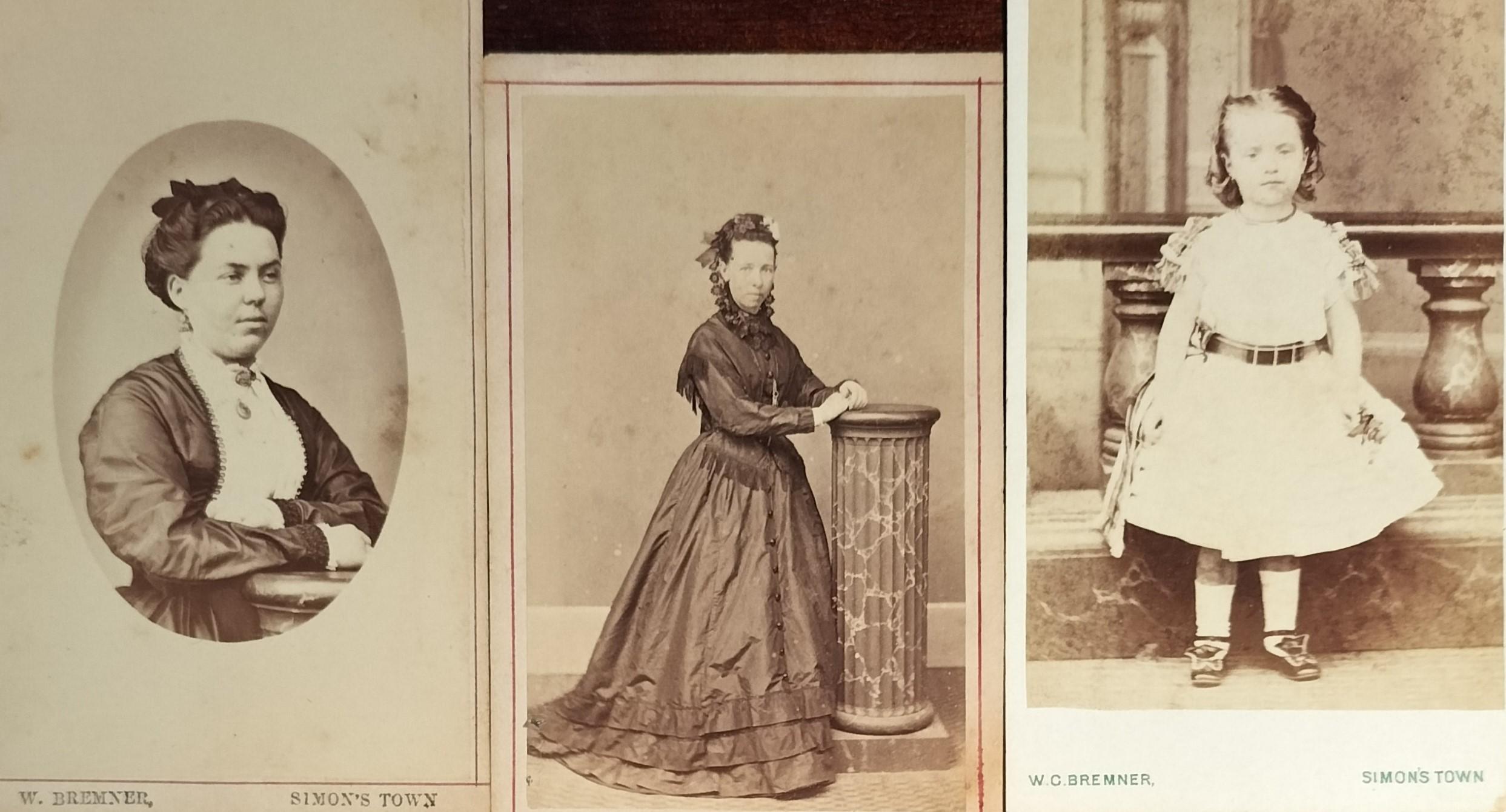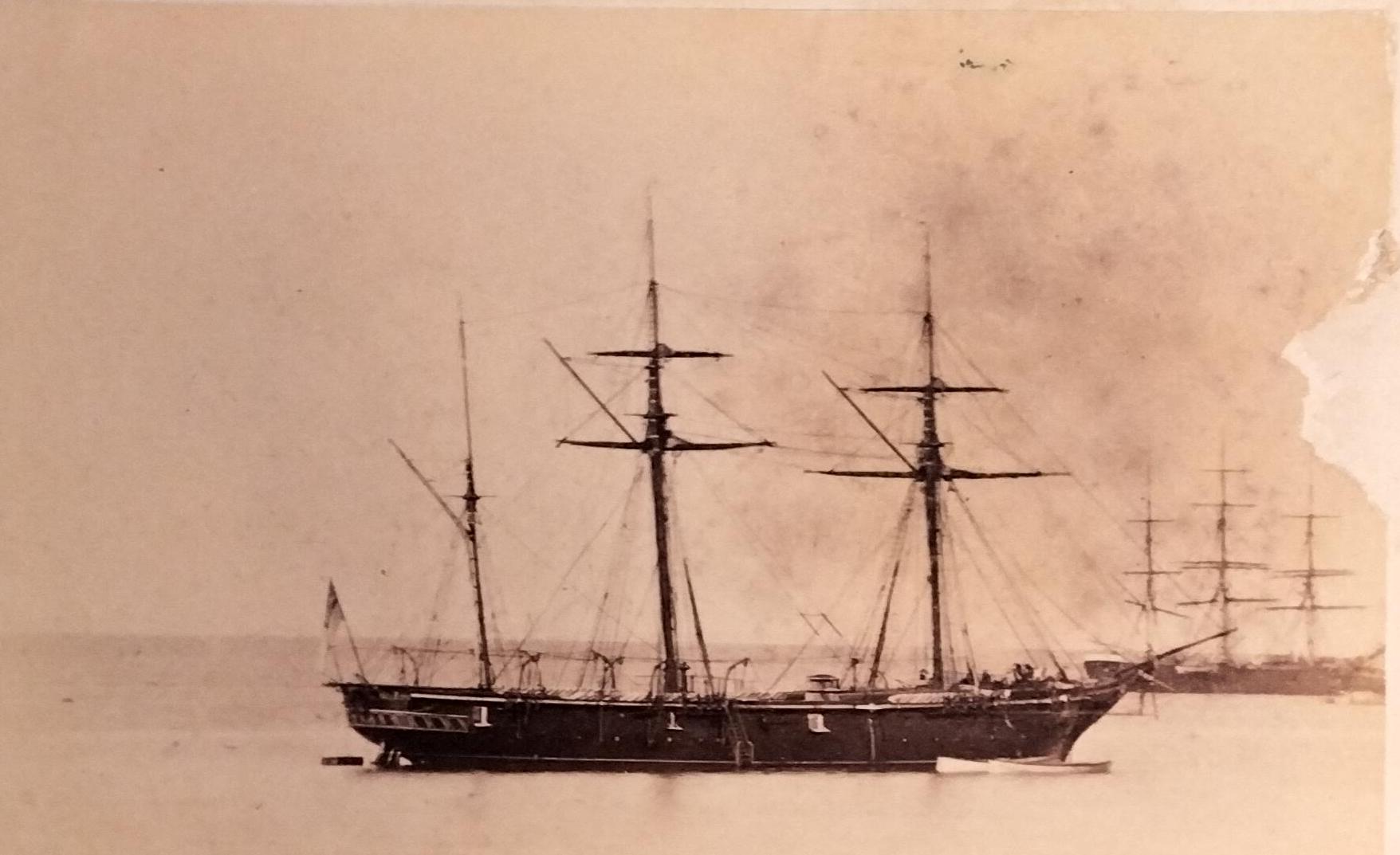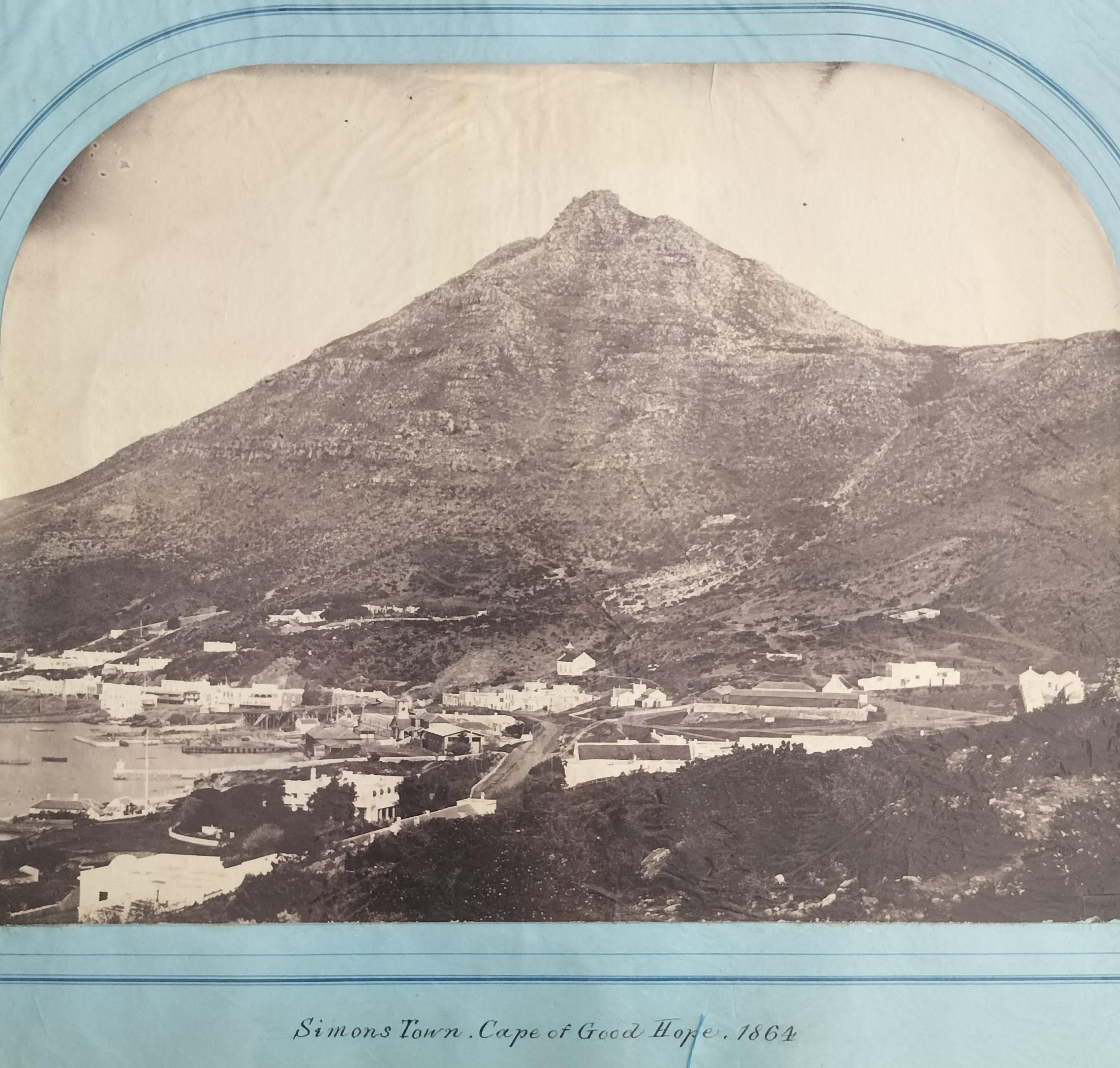
Disclaimer: Any views expressed by individuals and organisations are their own and do not in any way represent the views of The Heritage Portal. If you find any mistakes or historical inaccuracies, please contact the editor.
Some 25 years ago I bought a substantial portion of a homemade Victorian photograph album which has fallen apart. This album, containing more than 50 pages, was rescued by a Johannesburg-based book dealer. Each of these pages came neatly wrapped in plastic, with the detail of each page, where available, retained and included at the back of each page.
Years later, by absolute fluke, I cannot even remember when and where, I obtained the remainder of the album containing the hard cover front and back pages along with five additional pages with pasted photographs that the dealer possibly did not see as important to protect in a similar vein. It may even be that this second batch was not in the original dealer’s possession and that it surfaced from somewhere else. Irrespective, the likelihood of me finding the remainder of the album some years later, without searching for it, still boggles the mind.
By including the details of each page, the dealer ensured that some provenance was saved. Sadly, even after dissecting the content, the original owner of the album has not been determined beyond reasonable doubt. It is safely assumed to have belonged to the wife of a Royal Navy officer who was based in Simonstown between the period 1862 and 1869, the same period that the HMS Valorous did service in the Cape waters.
Unlike the majority of Victorian albums, where photographs could be slid into purpose-made pockets, photographs in this album are pasted onto blank pages. The original owner, who clearly had an exceptional artistic flair, patiently painted colour frames around each photograph and each page, one more elaborate than the next. This would have been a very time-consuming process.
The artistic work on each page alone was the key attraction for me. The real challenge was to interpret the content to determine the narrative it portrays. Attempting to make sense of the content of the album resulted in me going down various rabbit holes.
Because the Victorian photo album lacks clear provenance – much had to be intuited in putting this article together. Various inscriptions in the album and two specific photographs however refer to the HMS Valorous. This had to be my starting point.
Ships and war form a fundamental part of history, but so too did people – civilians as well as officers and sailors. This is particularly true in periods of ‘peace,’ such as the second half of the nineteenth century when the Royal Navy depended on a diverse range of personnel and warships stationed at various locations to manage local relations (McCreery, 2019). Through the analysis of the Victorian album under scrutiny, the navy’s presence and activity can therefore be better understood from the perspectives of individual officers, sailors and civilians based at Simonstown.
Three men attached to the Royal Marine Artillery (1861) in their civilian best – Halliday, Cuffe & Colomb
A larger format photograph of Mrs Gordon (1867), who in all probability was the wife to Captain Gordon attached to the Royal Navy. Another photograph in the album (see lower down) confirms that he had a house in Simonstown. Note the elaborate table.
JL Needham attached to the Royal Marine Artillery (1863). What makes this image unique is that the base of the neck brace can be seen at the bottom of his feet. Due to longer exposure times, the individual who had their likeness captured had to place their heads in the neck brace to hold their head still to prevent the image from becoming blurred.
1. HMS Valorous in Cape Waters
During the year 1864, the Royal Naval force on the East Indian and Cape of Good Hope Stations consisted of fourteen vessels stationed in Simonstown, among which were one battleship; five frigates, five sloops; two gun vessels, and a receiving ship. Seven of these vessels were on the station during the entire year whereas the others returned for periods varying between six to eleven months.
The HMS Valorous was one of the two 16-gun, steam-powered Magicienne-class second-class paddle vessels for the Royal Navy. She was launched at the Pembroke dockyard in 1851. Commissioned in 1853, she played a small role in the Crimean War (1854–1855). Between April 1863 and September 1867, she operated off the Cape of Good Hope under the command of Captain Charles Codrington Forsyth. Ironically, there is no photograph of Captain Forsyth included in the album. In 1868 the HMS Valorous was involved in laying the Atlantic Cable and was eventually sold for scrap in 1891.
HMS Valorous in Simonstown Bay (circa 1865)
2. Simonstown Naval base
In 1811 the Royal Navy decided to move to a new base at Simonstown, however, the initial facilities took approximately three years to complete and were not ready until 1814. Between 1815 and 1849 the base was mainly used for re-fitting and repair work on vessels and acted as a port of call for nautical surveyors who were mapping the region. During the 1850s and 1860s improvements were made to the dockyard facilities with some being re-built to accommodate larger ships. On 17 January 1865, it was combined with the East Indies Station to form the East Indies and Cape of Good Hope Station. On 29 July 1867, the station became a separate station. From 1870, it absorbed the former West Africa Squadron.
At the start of the South African War in 1899 a long period of relative peace had existed whereafter the station became the main base for British Forces disembarking and embarking during the war and for supplies and equipment being shipped from Britain for the duration of the conflict.
The history of the Cape Colony between 1806 and 1870 spans the period of the Cape Frontier Wars, which lasted between 1779 and 1879. The wars were fought between the European colonists and the native Xhosa who, defending their land, fought against European rule. This partly explains the presence of the Royal Navy and other British military forces in Simonstown.
The album dates from the time that Sir George Grey would have been the Governor of the Cape of Good Hope (1854 – 1870).
Photographs mattered to the nineteenth-century naval community. Surviving images therefore assist us in better understanding the Victorian Navy (McCreery, 2019).
3. Significance of the Simonstown Victorian Album
Considering that commercial photography was hardly 20 years old when the album was started, makes the album an even more significant heritage find from both a South African and Simonstown perspective (not ignoring the British Naval history aspect thereof).
The narrative presented through the photographs spans ten years, namely between 1861 and 1871. The owner of the album seems to have been back in the UK by 1869, meaning that any photographs included after 1869 no longer have a South African link.
In her work, McCreery (2019) primarily analysed, what she referred to as, the “Wits Album” and compared the content thereof with a more formal album along similar lines based in the United Kingdom.
Victorian Naval Officers and their families had a strong interest in photography. McCreery (2019) adds that they were early adopters of photography by photographing fellow officers, family members, civilians they engaged with and their immediate surroundings of the naval stations they were based at.
The album being analysed, curated in the HPRC, confirms McCreery’s (2019) observation that ordinary sailors were not often photographed, unless when part of a group on the deck of the ship.
McCreery (2019) continues by stating that given the years spent aboard ships and foreign stations most naval officers and sailors of the time socialised “on the job”. Such physical isolation from their own families and home communities was extreme, even by the standards of mass European migration. This also made relations with officers and civilians abroad more meaningful – a substitute family. Resultant photographs ensured durable records of these relationships.
In the album under analysis, many photographs depict naval officers in uniform while others show them in civilian dress. What stands out is the collegiality among the naval community.
Framed in red – Top left to right bottom are: Miss L Binger (1869), Captain Bridgford (attached to the Royal Marine Artillery - 1869), Miss Mary Louise Snowden (1870), E Liardet (attached to the Royal Marines – 1870) and WM Lambert (attached to Royal Military Artillery – 1870). Note the beards of two of the male sitters. Also, some of the photographs have been lightly hand-coloured, like many other images contained in the album.
Another beautiful painted page in the Victorian photo album. The female sitters are from top left to bottom right: Miss Maria Macaulay (1866), Miss Phiney Cloete (1865), Miss Emma Garcia (1866) and Mrs Scott (1866).
Four elegant ladies, from top left to bottom right: Miss Cecilia Henderson & Mrs Bayne (1866), Miss Denys and Miss Ixat (1865). Cecilia Henderson stands at a very unusual prop, namely a type of piano.
The sitters from top left to bottom right are: JL Needham and A Donald attached to the Royal Military Artillery (RMA) (1870), Mr and Mrs JS Bird (1870) and Miss Macbean. Mrs Bird is paging through a Victorian photo album. In front of them on the table is also a stereo viewer (two books placed on top).
Painstakingly painted frames. Only the two boys on the left of this page have been identified, namely CR Dawes (top) and FC Cook (bottom). Could it be that the ladies are their respective sisters/wives?
The content of the album suggests that officers and high-ranking civilians whom officers had contact with, sat down to have their likeness captured in the Carte-de-Visite format at either Simonstown or Cape Town studios. In Simonstown at least two photographers were active at the time, namely David McKenzie Selkirk and William Bremner. One or possibly both of them contributed to the photographs included in the album.
Of significance is that the album also contains a photograph of the Photographic Saloon in Simonstown where it is suggested that the majority of the photographs may have been captured. In addition, the album also contains a photograph of William Bremner and his daughter, further supporting the view that he was responsible for producing a sizeable percentage of the images in the album (See concluding comment below).
Sitters from top left to bottom right: MSJ Sunderland attached to 9th Regiment (1865), Monsieur Lavenére (1865), William Bremner (1866) and William Macaulay (1866). The William Bremner shown here in all probability could have been the Simonstown-based photographer.
Depending on the sitter’s budget, Carte-de-Visite photographs could be ordered as a single item or in batches of six or even twelve photographs (or any permutation in between). Where more than one photograph was requested, these would then have been sent to family and friends abroad or exchanged with local friends and colleagues – including crew of visiting foreign ships.
The overall impression created by the album is that of a very close-knit group that relied on the photographic end result to memorialise their experiences and connections made at the time. The album content indicates that naval officers, their wives and children engaged both with naval personnel and civilians as part of their daily routine.
McCreery (2019) confirms that outdoor photography at the time was technically more challenging as well as more expensive compared to studio-produced imagery. This explains why there are only a few outdoor images contained in the album. These outdoor images would have been bought from professional photographers.
It needs to be pointed out that while the images in the album are mostly stock-standard Carte-de-Visite-sized images, they have not been pasted on preprinted Carte-de-Visite card stock which typically contained the photographer’s name and location of the studio. This means that the images would have been obtained at a cheaper rate by the sitter whereafter it could be pasted into the album.
McCreery (2019) also points out that Prince Albert was a keen photographer himself and as a midshipman aboard HMS Euryalus on a previous visit to the Cape of Good Hope (in 1860). On this journey he brought along a camera that was used for capturing Carte-de-Visite images. This was allegedly the first such camera to arrive on South African shores. After his visit, he presented this camera as a gift to a local commercial photographer, Frederick York. Bull & Denfield (1970) elaborate that shortly after receiving this camera (made by Murray and Heath), which was capable of taking four portraits on one plate, York had already made arrangements to leave the country (April 1861) and had disposed of his photographic establishment, resulting in the camera being left to his successor Arthur Green who became the first recorded South Africa-based photographer to introduce the Carte-de-Visite format photograph.
Prince Albert visited Simonstown again in 1867. The album contained in the HPRC however contains no visual evidence of such a visit.
Although the “Wits Album” has not been seen by me, there is a link between the “Wits Album” and the album curated in the Hardijzer Photographic Research Collection (HPRC). The Victorian album analysed by McCreery (2019) and the Victorian album curated in the HPRC contains photographs of locals such as Mrs. Henderson and Miss Cloete. The presence of these women, along with other well-known Dutch (Boer) families such as Myburgh and Dupre confirm the relationships between Royal Navy officers and families developed with the local population. Contact with French dignitaries, such as the French Consul in Cape Town and Geroge Bell (see photographs included) further confirm the prestige associated by the British Naval officers to engage with local dignitaries. McCreery (2019) adds that relationships between elite Dutch and British residents were perhaps closer than historians have assumed.
These sitters were all photographed in 1868. Top left to the bottom right are Miss Macaulay, Mrs Bell, Mrs Colquhoun (small photograph) and Mrs & Mr W Bickford.
Although the artwork on this page is not very elaborate, the photographs remain significant. The top photograph shows the Simonstown cemetery. The photograph of the two women in the middle is inscribed as "our neighbours". The goat is described as the pet goat on the HMS Valorous. The individuals on either side of the centre image are described as the servants Rosu (left) and Morrel (right).
Beautiful hand-painted page in the Victorian album. The sitters are from top left to bottom right: Doctor Olive (1865), Mr Macaulay (1866), Assistant Paymaster Harries (1865) and Miss Aston.
4. Victorian Album dissected
The Victorian album that led to this article has a distinct link with the Victorian Royal Naval Officers and the local Simonstown community. For many of the images, sadly no definitive link could be made. Ongoing research would therefore be required.
The album contains photographs of at least 160 sitters where the names of 140 individuals have been recorded. Amongst these recorded sitters are roughly 63 soldiers attached to a variety of British military forces at the time, such as the Royal Navy, Royal Marine Artillery, 9th, 10th and 11th regiments and others.
The latter part of the album contains images of the UK towards the end of 1869 to 1871, suggesting that by that time the owner of the album had returned from her stay in Simonstown, she continued expanding the album.
All images in the album were captured by professional studio photographers.
The content of the album can roughly be divided into 6 categories, namely:
- Mariners that were attached to the HMS Valorous;
- Other British military force soldiers;
- South African-based citizens and residents of significance;
- Simonstown and surrounds;
- Cape Town and surrounds;
- United Kingdom (late 1869 onwards)
Somerset Hospital (foundation stone laid 18 August 1859) and the original Cape Town City Hall on Green Market Square, which was the first double-storey building erected in Cape Town in 1755. Photograph (circa 1867) by unknown photographer.
An unusual early panoramic view of Cape Town by an unknown photographer included in the Victorian album (circa 1868)
The top image shows the house of Captain Gordon who was attached to the Royal Navy. The image in the middle shows the house where the unknown owner of the Victorian Album resided. This same image folds out to produce a panoramic image of Simonstown.
The last of these six categories, namely scenery in the United Kingdom, would have been included in the album by the owner following their return from South Africa (Simonstown). These 5 pages, although interesting images, do not form part of this article. The rest of the categories have been woven into this article.
4.1 HMS Valorous staff
- Some of the photographs contained in the Victorian album are of various crew members on board the HMS Valorous. The following eight individuals, based on the inscriptions in the album, have been confirmed to have served on the HMS Valorous:
- Lieutenant Blake;
- Master Hewlett William. He married Margaret Amy Nosworthy in Simonstown in 1866. Records indicate the couple had a child born in Simonstown in 1871;
- Midshipman Forsyth (possibly the son of the Captain of the ship?);
- Paymaster Gordon;
- Paymaster John Pooley;
- Surgeon Samuel Grose – Doctor Grose was born at Great Torrington in 1837, and after studying for the medical profession at St. Thomas's Hospital, London he entered the Royal Navy in 1862, as an Assistant Surgeon. He retired from the Royal Navy through ill-health in 1874 and settled in civil practice at Melksham in Wiltshire. In 1871 he married Mary Cecilia Rossell;
- Surgeon John Murphy and Assistant Surgeon John Guitton Clarke.
Some of the officers were better socially networked than others. Not only is there no photograph of the Captain of the HMS Valorous (Captain Forsyth) included in the album but also no photograph of Richard Williamson, who was the Chief Engineer on the HMS Valorous by 1861. It is assumed that he would also have been part of the group of mariners who spent a considerable amount of time in Simonstown in the 1860s.
Top left to bottom right: Mrs Bayne (1866), Captain O’Brien attached to the Cape Mounted Rifles & Captain Whitmore attached to the Royal Engineers. The lady bottom right has been recorded as “DT.” Elsewhere in the album, the same lady is recorded as “D.E.T.”
The top two sitters on this page have not been named, but from other photographs in the album it is assumed that she must be the daughter of the Cape Town-based French Consul Ernest Héritte in that they appear on a photograph with Ernest and his wife in front of their house in Cape Town. They also appear in two more photographs in the album posing as a couple. The male is clearly attached to the British Military. The small photograph is of Lieutenant FC Law attached to the Royal Navy followed by Miss Shaw (bottom left) and Miss I Bell (bottom right).
From top left to bottom right (1865/67): Miss Macaulay, Miss Garcia, Mrs Dickinson. and Miss Netta Duprat. The last sitter (bottom right) has been recorded as “DET”.
Sitters from top left to bottom right are: W Hewlett (1862), Luly Symonds (1862), Mrs Hewlett and Mids. Wilding (1863). Note the top two slightly hand-coloured images.
The sitters are from top left to bottom right (1865/66): Reverend WW Garret, Lieutenant Law, Doctor Donovan, Doctor Clarke and Doctor Rose. Law appears elsewhere in the album as well.
4.2 Other British Military Personnel
- Colonel Henry Aylmer (1843 - 1918) - A Canadian who served in the Royal Military Artillery. He was also a Canadian politician. He was promoted to the rank of Colonel in the RMA in 1862. A record also exists of a Harry Aylmer (1813 – 1904) attached to the RMA
- Captain Sidney Thomas Bridgford (1836 - 1897) – Bridgford was born in Dublin and joined the RMA in 1855. He was promoted to Captain in 1867. Bridgford also did service in Japan where he published an article “A Journey in Yezo”
- Lieutenant Colonel John Cox Gawler (1830 – 1882) – He was present during the 1850/53 Xhosa war and became a magistrate in British Kaffraria (1855 & 1861). He married Clara Caroline Judge in Simonstown on 14 August 1855. In the 1870s Gawler became the Keeper of the Jewel House at the Tower of London, a position he held until his death
- Captain Samuel Hamilton Bunce Northcote (1843 - 1922). Northcote was married to Rhoda Ann Palmer. He was sent to the Zulu War but did not arrive in time to be awarded a medal. He was attached to the Royal Marine Artillery (Eastney).
- Henry Brasnell Tuson (1836 - 1916). Major – Also sent with Samuel Northcote to the Zulu War. No medal was allocated in that they did not arrive in time.
4.3 South African-based citizens and residents of significance;
Of interest is that the album does not contain many images of children. At least six of the images include dogs.
The photograph inscription reads: "Favourite dog at Simonstown" (1865). This must have been a favourite (and obedient dog) to have it taken to the photographer's studio. It is assumed that the photograph was captured in a Simonstown photographic studio. Photographing dogs (and children) was particularly challenging at the time due to longer exposure times.
ET Risk attached to the Royal Marines with his pet dog (1862). The dog is slightly blurred due to movement. Note the glove on Risk’s left hand and the cigar in his right hand.
Some of the Cape of Good Hope residents who appear in the Victorian album include:
- Charles Davidson Bell (October 1813 – April 1882)
Bell was born on 22 October 1813 at Newhall, Crail, Fife, Scotland and left Scotland for South Africa aged 17 (1830) to eventually become the Surveyor-General in the Cape Colony. He was also an artist, heraldist, and designer of Cape medals and stamps.
His sensitive portrayals of the mixed population of Cape Town and of the ethnic groups he encountered on the Smith expedition to the north in the late 1830s have become an invaluable record of life in 19th-century South Africa.
Bell also designed the arms of the South African College (now the University of Cape Town), and the "three anchors" badge of the South African Mutual Life Assurance Society ("Old Mutual"), of which he was chairman at one time. Both emblems are still in use and may well be the oldest academic arms and corporate logos in South Africa.
Bell married Martha Antoinette Ebden on 3 June 1841, but the couple divorced nine years later upon which Bell was granted custody of their three children. Another 9 years down the line, Bell married Helena Krynauw on 7 July 1859.
After his retirement in 1872, he returned to Scotland in 1873 with Helena and their 3 surviving children (the youngest two of their children died at a very young age in 1865), where Helena Bell died on 10 September 1881 and Bell died on 7 April 1882.
Top left is Charles Bell and four-year-old Alick standing in front of him (1865). Alexander (Alick) Bell, Bell’s first son from his second marriage, was born on 15 September 1861 in Cape Town. The image on the right is of Alick again with the smaller image at the bottom being that of Mary Bremner, assumed to be the daughter of the Simonstown-based photographer William Bremner (1866).
One of the people of significance found in the album is Charles Davidson Bell (22 October 1813 – 7 April 1882). In the album, Bell appears with his son Alexander (Alick aged) around 4 years old. This self-portrait of Bell was extracted from Wikipedia.
- Ernest Héritte – French Consul
Other than his appointed as the French Consul in Cape Town in August 1864, little is known about Ernest Héritte. The number of photographs of him and his family in the album indicates that they were well-integrated with both the British and the local community of Simonstown.
It has been recorded that Ernest, as an amateur mineralogist, contributed to the assessment in 1867 of the first “glittering pebble” found in Kimberley. He confirmed with the likes of Dr Atherstone and Louis Hond that the stone was indeed a diamond.
Also appearing in the photographs is Ernest’s French-born wife. Ernest was married to Louise Pauline Marie Héritte-Viardot (1841 – 1918) who was a French singer, pianist, conductor and composer. Viardot’s performing career was however ended by illness.
When the couple got married in 1863, Ernest was still the Honorary Consul and Chancellor of the Embassy of France in Bern.
Ernest Héritte - the French Consul in Cape Town - appointed in August 1864. The first shiny pebble found in Kimberley was brought to Cape Town, where it was assayed by amongst others, the French consul, Ernest Héritte (appointed Aug 1864) – an amateur mineralogist who confirmed that it was indeed a diamond and valued it at £500. This photograph was captured in 1867 by an unknown photographer.
Mrs Héritte-Viardot (The French Consul’s wife) and their pet dog. Louise Pauline Marie Héritte-Viardot (1841 – 1918) was a French singer, pianist, conductor and composer
- Reverend WW Garret
Although no information could be obtained about the Garret family, the album contains individual images of him, his wife (with a baby on her lap) and their two other children, Willie and Annie.
Miss Harriot on left (1868). Note the photograph number 8650A. Also note the elaborate table. The remaining three photographs are of the Garrett family, namely Mrs Garrett (1869) and Annie and Willie Garrett (1868)
- Reverend Thomas Micheal Aloysius Meagher
Irish-born Meagher died in Simonstown in 1908. He was single.
- Simonstown/ Cape Town-based sisters
Of interest is that the album presents at least three sets of sisters. Two of those sets are omnipresent in the album. It creates the impression that they were the local socialites. They are the sisters Dora and Johanna Fleck and Cato Myburgh and her unnamed sister. The other, set of sisters are Johanna and Magdalen Berrange.
To the exclusion of Cecila Henderson and Cloete already referred to, other ladies who stand out and are assumed to be South African are Netta Duprat and Emma Garcia.
View of Simonstown (middle - circa 1867). The inscription on the top image states: "Group taken by front door of Photo Saloon day after our ball. The inscription on the bottom image states: “Secretary Brown in his dogcart plus Photographic Saloon – 1867”. The large window of this corrugated iron building was put in place to allow light into the photographic studio. It is not clear who the photographer was. It could either have been William Bremner or David Selkirk, both of whom were active as photographers in Simonstown at the time.
Enlarged group photo above. Group photo at the front door of the Photo Saloon in Simonstown a day after a ball. The little boy on the left is blurred due to his moving at the time the shutter was released. At least four of the men are in uniform (1867). The four ladies seated in front (in white), are the Fleck and Myburgh sisters. See photograph below.
Local ladies photographed (1867). Left are the sisters Johanna and Dora Fleck, and right are the Myburgh sisters. The Myburgh standing is Cato. The Myburgh sister seated on the right is unnamed.
Closing
Although some of the photographs contained in the Victorian album under analysis would have been captured in the UK, many of them were captured in Simonstown and/or Cape Town.
As an example, the outdoor group photograph (see above) taken outside the Simonstown Photographic Saloon includes the Fleck and Myburgh sisters. They also appear in a studio photograph in the same clothing, suggesting the image was captured the same day in the studio. The backdrop to this image provides an answer to the question in that is a relatively common background seen in many of the images, namely a black/grey backdrop. Based on this hint, it could conservatively be suggested that at least 50 of the photographs originate from the Simonstown Photographic Saloon, with the remainder originating from Cape Town and the United Kingdom.
Was the photographer of these Simonstown Photographic Saloon images William Bremner or was it Selkirk who is known to have owned the Royal Photographic Saloon in Cape Town between 1864 and 1868 (with a possible satellite studio in Simonstown)?
I would like to suggest (for now) that it was William Bremner in that an image of him is also included in the album.
Individual Carte-de-Visite photographs from the Hardijzer Photographic Research Collection confirming William G Bremner’s link with Simonstown as a photographer. The background of the photograph also appears in the Victorian Album confirming that Bremner would have been the photographer of many of the photographs that appear in the album. The three ladies on the left are unknown. The photograph on the right is of Dr Mitchell and his wife. It could not be determined which ship Mitchell was attached to (circa mid-1860s).
Variety of Carte-de-Visite format photographs in the Hardijzer Photographic Research Collection taken by William Bremner in Simonstown (circa mid-1860s). No match of the backgrounds in these images could be made to photographs in the Victorian photo album.
A Carte-de-Visite format photograph in the Hardijzer Photographic Research Collection taken by Wiliam Bremner in Simonstown (circa mid-1860s). It is thought to be the HMS Valorous. The same ship also appears in the Victorian album confirming the Bremner link.
Notes
I attach the worksheet used in dissecting the album content to assist British Naval historians and genealogists alike in potentially furthering research on the album content (click here to view).
The plastic sleeves in which each of the pages was placed were not removed when photographing the images for inclusion in this article, therefore potentially having a slight impact on picture quality
Some surnames may have been spelled incorrectly in the photo album inscriptions.
Main image: Early view of Simonstown in 1864 by an unknown photographer. Part of the harbour is visible on the left. Simonstown was founded in 1680.
About the author: Carol is passionate about South African Photographica – anything and everything to do with the history of photography. He not only collects anything relating to photography, but also extensively conducts research in this field. He has published a variety of articles on this topic and assisted a publisher and fellow researchers in the field. Of particular interest to Carol are historical South African photographs. He is conducting research on South African based photographers from before 1910. Carol has one of the largest private photographic collections in South Africa.
Sources
- McCreery, C. (2019 - extracted 28 Jan 2024). Navy, nation and empire: nineteenth-century photographs of the British naval community overseas. (academic.oup.com)
- Hardijzer Photographic Research Collection
- Lipschitz, M.R. (1992). The Charles Davidson Bell heritage trust collection: A catalogue and critical study (https://open.uct.ac.za)
- Unknown (extracted 14 February 2024). HMS Audacious (1869). (en.wikipedia.org)
- Unknown (extracted 14 February 2024). HMS Valorous (1851). (en.wikipedia.org)
- Unknown (extracted 20 February 2024). Health of the Navy 1864 – Cape of Good Hope and East Indies Station. (https://freepages.rootsweb.com).
- Unknown (extracted 24 January 2024). HMS Valorous. (https://www.pdavis.nl)
- Unknown (2013 – extracted 28 January 2024). Grahamstown and the Eureka diamond. Makana Tourism. (www.grahamstown.co.za)
- Unknown (extracted 28 January 2024). Commander in Chief – Africa (Royal Navy) (en.wikipedia.org)
- Unknown (extracted 28 January 2024). History of the Cape Colony from 1806 to 1870. (en.wikipedia.org)
- Unknown (extracted 28 January 2024). Charles Davidson Bell. (en.wikipedia.org)
- Unknown (extracted 24 April 2024). Louise Heritte-Viardot (en.wikipedia.org/wiki)
- Unknown (extracted 24 April 2024). Royal Navy Surgeons (sites.rootsweb.com)
- Unknown (extracted 24 April 2024). Royal Navy Paymasters (sites.rootsweb.com)
- Unknown (extracted 6 May 2024). John Cox Gawler (en.wikipedia.org/wiki)
Comments will load below. If for any reason none appear click here for some troubleshooting tips. If you would like to post a comment and need instructions click here.

